Sustainability
To achieve a more sustainable world for generations, everyone must embrace greener, cleaner ways of working. Sustainability is high on the ERIKS agenda, and in this edition, we explore a range of topics to help us all reduce the impact we have on the environment. We look at ways in which we can improve efficiency, reduce waste and mitigate the risk of pollution.
ERIKS In Action
Walk Less. Run Better.
Time really can mean money and when it comes to maintenance every second can impact your balance sheet. An innovative vending solution from ERIKS helped one customer optimise their engineers time, reduce PPE wastage and improve efficiency.
In Focus
How thinking in circles saved steel, energy, and CO2
The decision to remanufacture vs. replace can offer huge benefits. Eliminating waste, improving lead times, and reducing the impact on the environment. SKF’s approach delivers significant CO2 and energy savings for one paper manufacturer. Page 24.
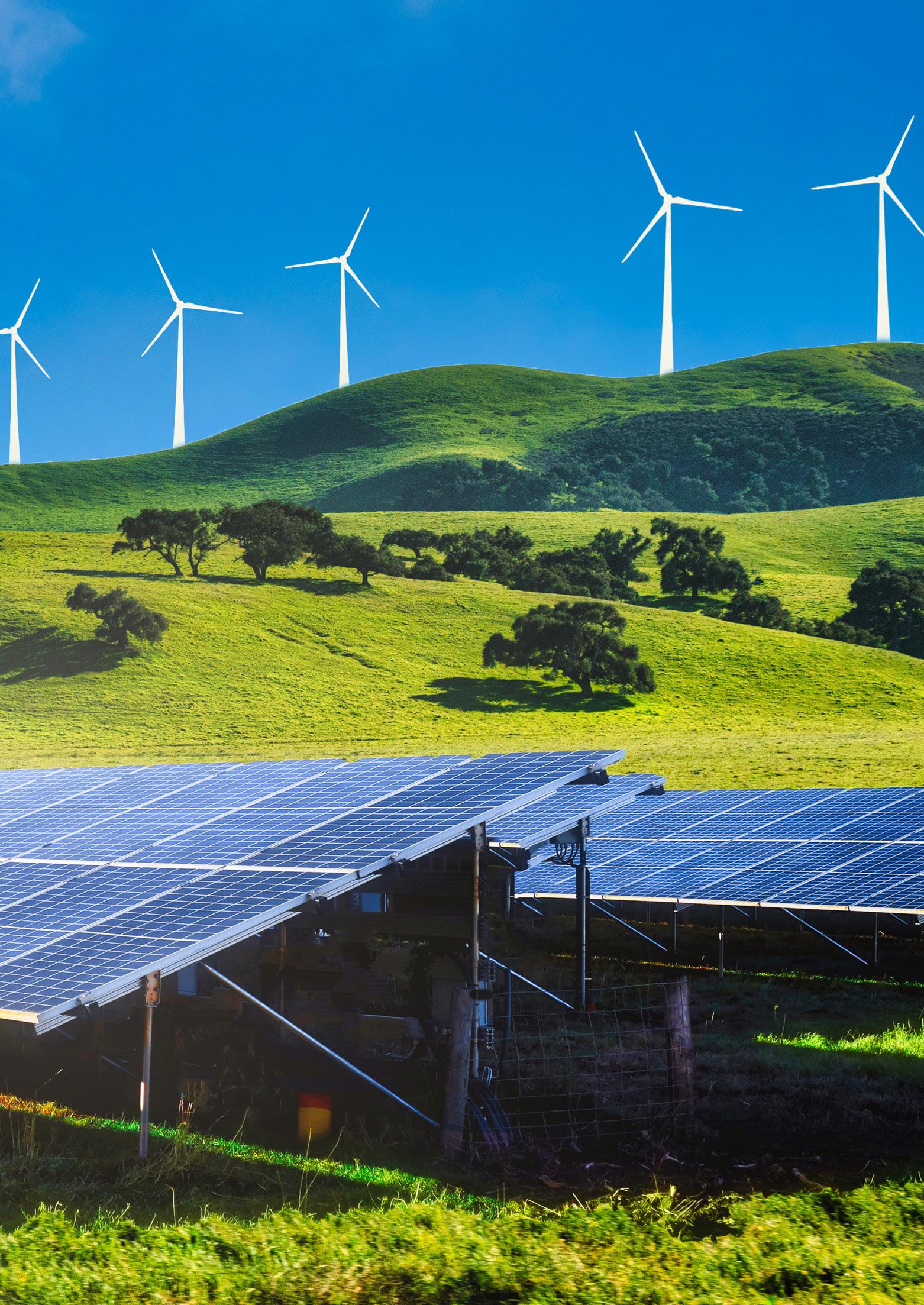
Debate
UK Growth: think beyond the sound-bite!
Have we fallen victim to seeing only what is right in front of us? Right now, with the focus often being short-term rather than long and the gains that can be made instantly, have we failed to notice the problems associated with short-termism. Page 56.
ISSUE 47
Automated machine monitoring for reliable rotation
Increasing demands on plant performance puts increasing pressure on machinery. To avoid unnecessary downtime, equipment needs to be monitored more often. As less time and resources are available for manual walk-arounds, automation is crucial.

Now there is a new way to achieve reliable rotation, and a new way to purchase it. SKF Enlight Collect IMx-1 sensors allow you to
build an automated machine monitoring system powered by cloud based IoT solu tions and AI driven analytics. It is wireless, easily scalable and connected to SKF Rotat ing Equipment Performance Centers. Get started with a fee-based contract and access automated predictive maintenance on your operating budget.
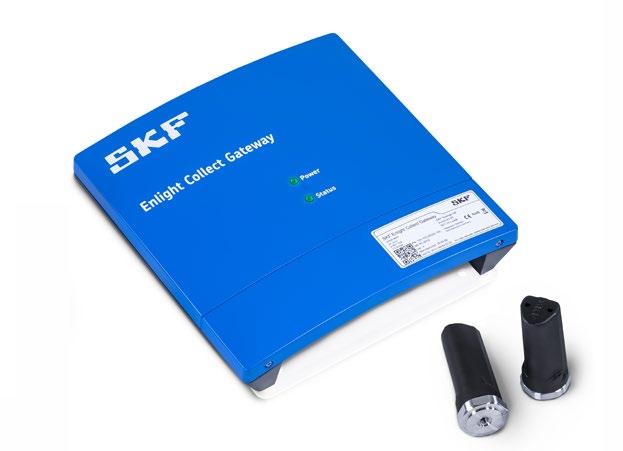
® SKF is a registered trademark of the SKF Group. | © SKF Group 2022
Welcome
With the world in a time of great economic, environmental and political change, there has never been more need to focus on how we can bring increased sustainability and reliability to the way that we work.

In this edition of Know + How, we take a deep dive into some of the issues that our clients are facing and how we can collectively rise to meet those challenges through collaboration and innovation.
Epitomising this spirit of partnership is Schaeffler, who in 2021 was voted one of the UN’s 50 Sustainability and Climate Leaders. In our In Focus section, discover how they are working to achieve a target of climate neutrality. In addition, we highlight some of the changes being made at ERIKS to improve our own green footprint, along with the services we offer to help you achieve your CSR goals.
Sometimes, challenges can arise from the simplest of scenarios with accessibility and time management playing a critical role in maximising efficiency and minimising waste. Find out how a custom-designed storage and dispensing solution helped elevate performance for a pharmaceutical client in our ERIKS in Action section.
Making our everyday services fast, effective and painless is another way that we can

support our clients in their sustainability and reliability journey. In Making Industry Work Better, we take a detailed look at improvements introduced to our new webshop that makes sourcing industrial parts cost-effective and hassle-free.

The value of teamwork has always underpinned the ERIKS ethos, both within our own organisation and in our client relationships. We are committed to meeting the challenges faced by industry and the wider world through collaboration and consistency. We hope this issue provides some food for thought on how this can be achieved. We would love to hear your thoughts! Join the discussion by emailing or tweeting us @ERIKS_UK
Richard Ludlam Editor-in-Chief
Email me at: knowhoweditor@eriks.co.uk

eriks.co.uk
Published by ERIKS Industrial Services Seven Stars Road, Oldbury, West Midlands, B69 4JR, United Kingdom
In
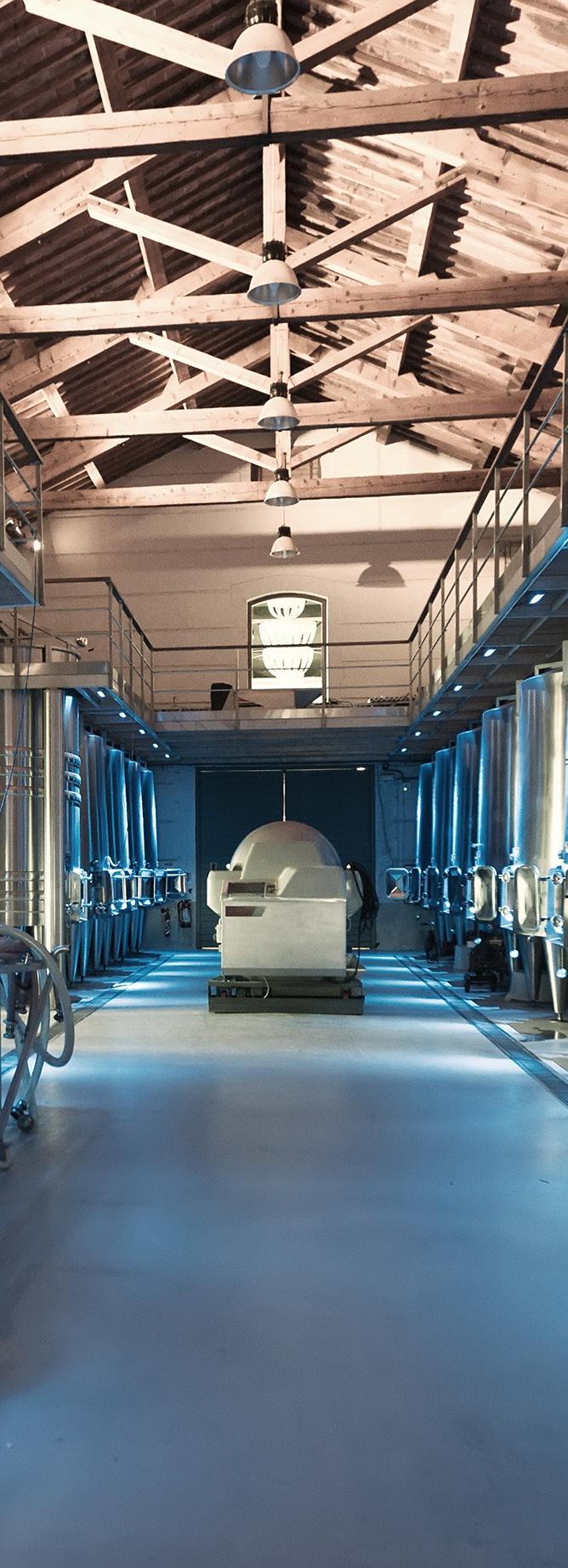



08 10 The positive spin on lockout/ tagout Walking less. Run better.
this
06 Keeping better tabs on energy use 06 Keeping better tabs on energy use 06 Liverpool’s in the lead in UK’s race to Net Zero 07 MakeUK survey reveals how British manufacturing is setting the standard for decarbonisation 07 UK government looks to subsidise energy-intensive industries 07 New R&D programme helps SME manufacturers cut 3,850 tonnes of CO2 08 The positive spin on lockout/tagout 08 World-first Igus energy-chain goes the distance 09 Smart Air Injection: Energy-efficient Long-distance Pumping 09 Schaeffler goes shopping 09 Safety bottles for the feet, from Rockfall 10 Walk less. Run better. 12 Baked-in know how saves dough 14 Why wait until you can’t wait? NEW ELECTRIC MOTORS LEGISLATION COMING JULY 2023 Issue 47
issue Latest News Technology Update ERIKS in Action


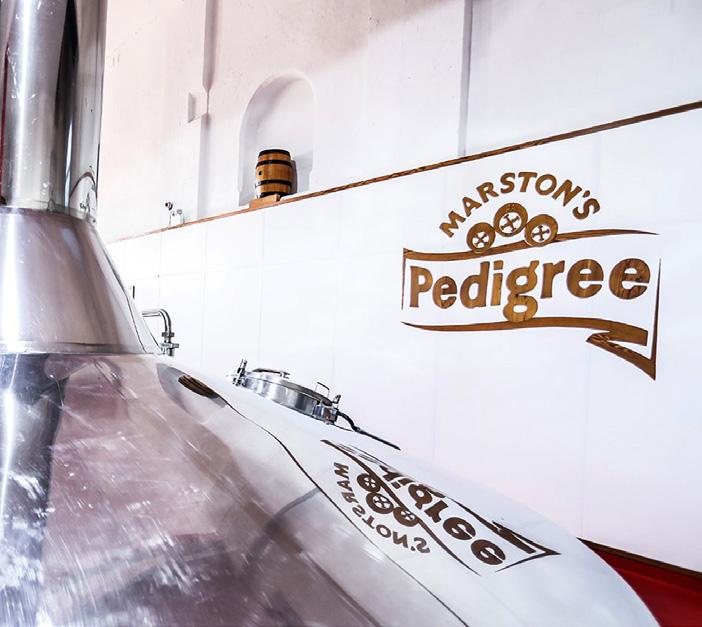


48 56 In Focus Making Industry Work Better Debate Know+How Open for (even better) business UK Growth: think beyond the sound-bite! A brewer chills out over costs and reliability ISSUE 47 Subscribe today and never miss an update eriks.co.uk/subscribe NEVER MISS AN ISSUE 44 16 Walking the walk towards a sustainable business 20 We’re all in this together 22 Don’t throw your money away 24 How thinking in circles saved steel, energy and CO2 26 Roll-up, roll-up! 28 Spills without the thrills 30 Take control of linear motion and you take control of your energy use 32 How your electricity bill can save you money 34 Don’t get caught in the steam trap 36 When water and oil do mix 38 Why lubrication is worth looking into 40 How to align cost savings with sustainability 42 Where sustainability goes hand-in-hand with safety gloves 44 A brewer chills out over costs and reliability 56 UK Growth: think beyond the sound-bite! 58 No substitute for know-how 46 Protecting your bearing investment 48 Open for (even better) business 50 Have you seen the light? 52 Does your PPE stand for ‘Pen and Paper Exercise’? 54 Fast Track to Success eriks.co.uk ISSUE 47 In Focus How thinking in circles saved steel, energy, and CO2 The decision to remanufacture vs. replace can offer huge benefits. Eliminating waste, improving lead times, and reducing the impact on the environment. SKF’s approach delivers significant CO and energy savings for one paper manufacturer. Page 24. Debate UK Growth: think beyond the sound-bite! Have we fallen victim to seeing only what is right in front of us? Right now. With the focus often being short-term rather than long and the gains that can be made instantly, have we failed to notice the problems. With short-termism on the rise is it time to address the issues of today and see the bigger picture? Page 56. Sustainability To achieve a more sustainable world for generations to come, sustainability must be a personal goal for all of us. At ERIKS, sustainability is high on our agenda. In this edition we explore a range of topics to help us all reduce the impact we have on the environment. We look at ways in which we can improve efficiency, reduce waste and mitigate the risk of pollution. ERIKS In Action Walk Less. Run Better. Time really can mean money and when it comes to maintenance and every second counts. An innovative vending solution from ERIKS helped one customer optimise their engineers time, reduce PPE wastage and improve efficiency. Page 10.
Keeping better tabs on energy use
You can’t control what you can’t measure. So to help energy end-users on the shopfloor acquire standardised energy information from their machines and components, four industrial automation and manufacturing groups have formed a joint working group.

ODVA, the OPC Foundation, PI (Profibus and Profinet International) and VDMA will be working together to develop a standard interface, based on OPC UA. The result will be energy information provided in a standardised way as part of the Global Production Language.
The details of the interface will be included in future releases of the OPC UA for Machinery specification. While PI and ODVA are contributing their knowledge of energy interfaces at the field level, the OPC Foundation is defining semantics and secure data transport, which will serve as the foundation of the Global Production Language developed by VDMA.
The standardised information which the working group’s collaboration will provide will ultimately make it easier for energy end-users to achieve their environmental, social and corporate governance goals.

Liverpool’s in the lead in UK’s race to Net Zero
The UK government set out a global strategy in the race to Net Zero back in October 2021. Helping the UK get ahead in this race, is a revolutionary Liverpudlian partnership that aims to accelerate the decarbonisation of the global chemical and materials supply chain.
The partnership between Unilever, the Materials Innovation Factory and the University of Liverpool is set to help eliminate fossil-based carbon and non-biodegradable ingredients in FMCG products.
Jonathan Hague, Head of Clean Future Science and Technology for Unilever and Chairman of the Liverpool City Region Innovation Board commented “As an industry, we have to break our dependence on fossil fuels, including as a raw material for our products…We hope to demonstrate what can be achieved when a business sets the elimination of fossil carbon in its targets and are proud to be doing so with the support of our partners in the Liverpool City Region.”
LATEST NEWS
Issue 47
MakeUK survey reveals how British manufacturing is setting the standard for decarbonisation
At this year’s Siemens Transform event, CEO of MakeUK, Stephen Phipson, discussed the results of their survey titled: Decarbonising Manufacturing –Challenges and Opportunities.
Stephen spoke about how valuable manufacturing is to the UK economy. The average salary is 35% above the national average when compared to other sectors, it employs two and a half million people across the UK, and it represents 65% of research and development investments in the UK.
Stephen commented “8 out of 10 manufacturers within our membership are now saying that decarbonisation is a high or medium priority in their business. That’s a massive change from where we were not that long ago – 46% of manufacturers are in the process of already implementing plans in their factories to move towards decarbonisation.”
“Unfortunately, many of the discussions with the government are longer term, and what many manufacturers want is to see it happening quickly. We’re therefore very pleased to see the progress made in this report.”
UK government looks to subsidise energyintensive industries
After months of soaring gas and electricity bills and a looming national recession, the government is pondering potential proposals that will help to lower bills for energy-intensive industries.
They’re considering plans where 300 businesses would be supported, sustaining approximately 60,000 jobs. The government proposals would mean lower costs for industries such as ceramics, glass, paper, steel and cement.
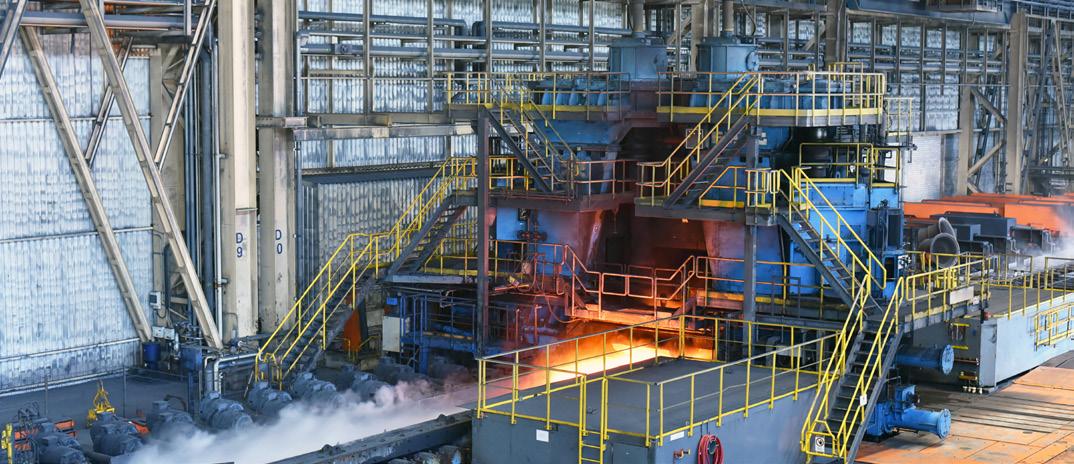
The Department for Business, Energy and Industrial Strategy said the scheme reflected the fact that UK companies faced higher industrial electricity prices than those in other European countries, meaning their potential investment opportunities and commercial viability would be at risk, decreasing competition and negatively impacting trade for British firms.
Former business secretary and newly appointed UK chancellor, Kwasi Kwarteng, commented on the proposed plans. He said, “British manufacturers are the lifeblood of our economy and central to our plans to overcome this period of economic uncertainty…It is essential we explore what more we can do to deliver a competitive future for those strategic industries so we can cut production costs and protect jobs across the UK”.
New R&D programme helps SME manufacturers cut 3,850 tonnes of CO2

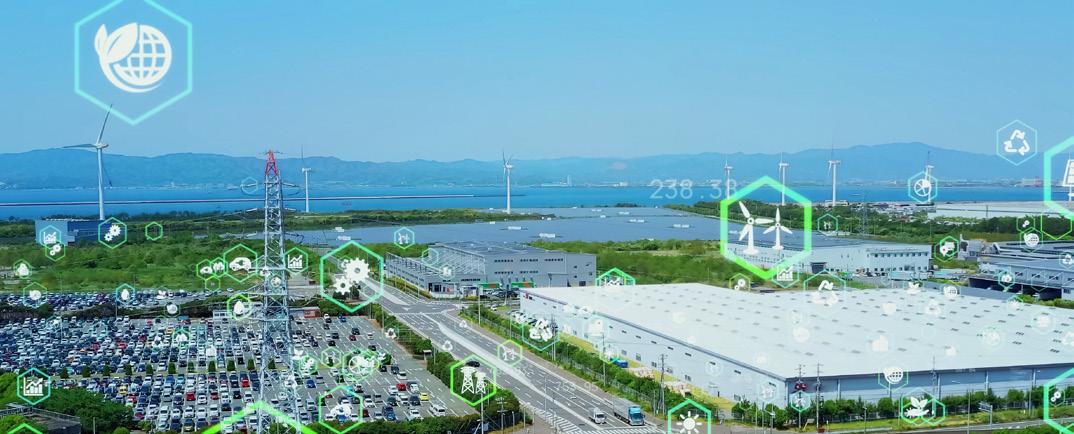
Eco-I North West, an R&D initiative, is helping to cut CO2 emissions through business-university collaborations. The initiative works in partnership with six leading regional universities to develop low carbon innovations for SMEs from any sector.
The three-year programme (now in its final year) is working with more than 180 SMEs across the region. The programme is on target to have helped 369 businesses create new sustainable technologies to accelerate green economic recovery by the target year in 2023.
A manufacturer of slate products, Coniston Stonecraft, is working with the university of Cumbria to decarbonise its production, packaging and distribution processes. Managing director, Brendan Donnelly, said “I would encourage all business in the North West to get involved in this initiative. Expert advice can help you build your brand, save money and, in doing so, save the environment.”
Eco-I NW offers SMEs access to fully-funded interns from a pool of students across the six universities, postgraduate researchers and capital grants.
7
eriks.co.uk
The positive spin on lockout/tagout

An innovative new Spin Cable Lockout device from Brady makes it easier to lock out difficult to secure isolation points – including valves, handles and oversized devices.
The Brady Spin System is available in options with or without cable; in a choice of colours for easy identification; and in an extra-security version with a tool provided for opening the security mechanism. However all versions have a small footprint, allowing them to be stored with the machine or at the point of use, without taking up valuable space.
The adaptability of the Spin Cable Lockout device means it can be used for a wide range of applications, replacing many application-specific devices and saving time and storage space as a result.
Made to a sturdy, resilient and ergonomic design, and highly resistant to chemicals, the Brady Spin Cable Lockout can be locked directly by up to 6 padlocks (the manufacturer recommends Brady SafeKey padlocks), or by even more with the addition of a lockout hasp.
World-first Igus energychain goes the distance
While drum and cable systems severely limit how far rail-mounted automated tracking cranes (ASCs) can travel, the new driven energy chain from Igus can reach to well over 1km.
Drive boards mounted on the outer radius of the e-chain drive it in the lower run, while the new system also has motor-driven friction wheels on the sides of the bottom rail, together with rollers on the top. When the chain starts to move, the friction wheels’ motors start, and the lower run travels along the rail in synchronised movement.

The new system allows ASCs to accelerate at 5-6m/s and travel at 6m/s, with no braking required at the middle of travel to allow a cable guidance system to pivot.
With hardly any push/pull forces on the chain links, the Igus e-chain operates with minimal load, ensuring low wear and long service life. And with no increase in overall weight – so no extra system drive power required – the Igus e-chain goes even further to reduce costs.
TECHNOLOGY UPDATE
Issue 47
Smart Air Injection: Energy-efficient Long-distance Pumping
Designed to convey highly viscous and non-flowable products, SEEPEX Smart Air Injection (SAI) combines a custom-built progressive cavity pump with compressed air conveying, in a tailor-made system. One that gives you lower costs, reduced energy consumption, longer service life – and longer transport distances.
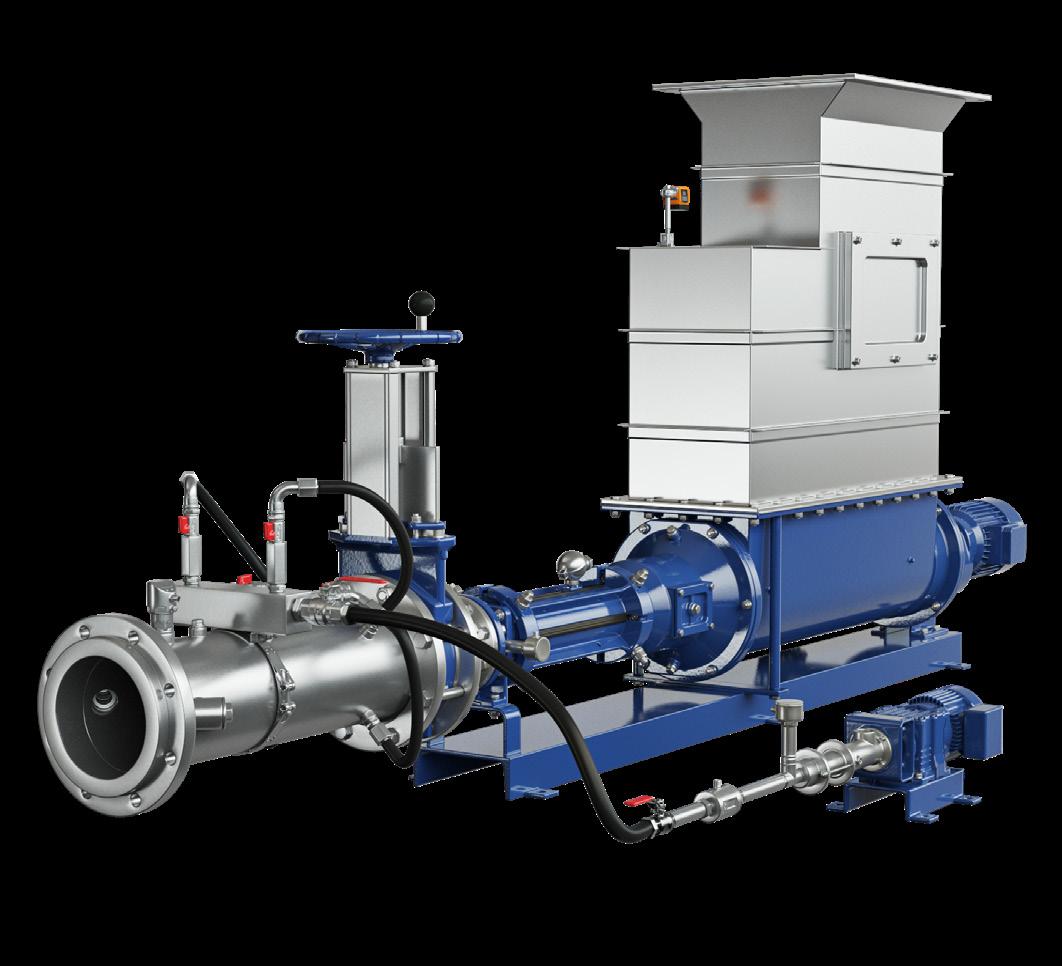

Compared with conventional conveying technologies, the Smart Air Injection (SAI) system reduces energy consumption by up to 72%. And that’s over transport distances of up to 1,000m. Direction changes and height differences don’t present a problem either, thanks to the system’s flexibility.
The lower pressure in the conveying pipeline reduces pipework wear, which means lower repair and replacement costs. When maintenance eventually is required, Smart Conveying Technology and the Maintain-in-
Schaeffler goes shopping
Place concept mean the rotor or stator can be changed in less than an hour – even when space is limited.
Control and monitoring are easy via the SAI controller, and integration into all automation and control systems is simple. All of which makes the SEEPEX Smart Air Injection system the smart choice for your compressed air system.
In a major expansion of its portfolio of linear technologies, Schaeffler is in the process of buying the Ewellix Group. A market leader in several technology areas, Ewellix Group is focussed on highgrowth niches in the linear motion market.
The deal, expected to close by the end of 2022, will enable Schaeffler to focus more closely on three growing industry trends: the replacing or supplementing of hydraulic and pneumatic systems with electromechanical options; efficiency improvements; automation and robotics.
Ewellix’s modular range of actuator technologies enables it to build customised, application specific systems, quickly and cost-effectively. This will help Schaeffler to tailor its products more closely to customer requirements in this area, and will unlock more customised capabilities based on smart design principles.
As Dr Stefan Spindler, CEO of Schaeffler’s industrial operations, pointed out: ‘Schaeffler and Ewellix
Safety bottles for the feet, from Rockfall

Manufacturing one pair of Rockfall sustainable boots uses the equivalent of 5 plastic bottles’ worth of recycled plastic. The polyester uppers are 100% recycled. And even the laces are 100% recycled material. But there’s no compromise on safety, comfort or wear resistance.
With sustainable materials featuring across the range, choosing any pair of Rockfall Boots will help the environment. But two examples show the key benefits to the wearer of choosing sustainability as well as safety.
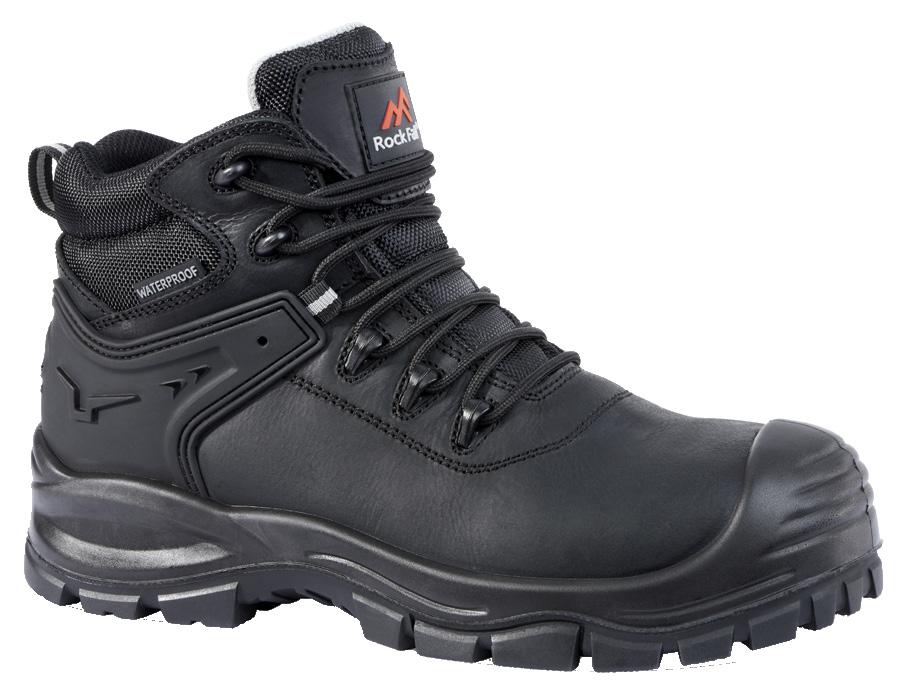
The Rockfall RF910 Surge is certified to withstand electrical risks of 18kV. The 100% non-metallic boot also has an Activ-Tex® membrane tested to be waterproof for 8 hours, and tongue, collar, lining, webbing and trims all include up to 100% recycled materials.
The RF205 Herd also features the Activ-Tex® waterproof membrane, and a recycled plastic bottle upper, webbing and laces. Like the RF910 Surge, it includes the Activ-Step® PU anti-fatigue comfort footbed.
With green credentials like these, Rockfall boots help you put your best foot forward for sustainability.
9
eriks.co.uk
Walk less. Run better.
Jamie Perry Business Development Manger, VMI Solutions

Keeping production running reliably demands that maintenance and repairs are carried out quickly and efficiently. Which was never going to happen for a major pharmaceutical company, when their technicians were spending up to an hour walking to Stores and back to retrieve spare parts. That’s why they asked ERIKS to step in and help them find a more efficient way to provide technicians with parts – short of providing them with bicycles.
It wasn’t only the distance from the production line to Stores that made retrieving parts so time-consuming. It was also the fact that the line operated in a sterile environment. So every time a technician left the production area, they had to change out of sterile clothing, and change back into it again on their return.
Agency and temporary workers created even more issues. Supplied with disposable sterile clothing, they required a new outfit every time they returned to the production line –generating cost, wastage and environmental impacts.
not required to meet the same levels of traceability, accountability and certification as those used in this sterile production area.
The more stringent requirements for the new parts storage unit meant more challenges in store for the Vending Solutions team from ERIKS Storeroom Services.
Taking the biscuit
The first stage in providing more efficient and faster access to parts was a thorough review of the situation.
necessary clothing for a sterile area, and every single part took almost three-quarters of an hour to acquire.
With the Stores located right next-door to the canteen, another 15 minutes or so was often added to each round trip: just time for a cheeky cup of tea and something to eat.
Based on the time taken, the average hourly wage, and the number of trips made, it was calculated that the spares ‘walk and wait’ was costing the customer over £300,000 per annum. And that excluded the cost of any downtime if production was halted while a part was acquired.
Devising and installing a new time-saving storage solution was clearly something that –unlike the technicians – couldn’t wait.
Cracking the code
ERIKS had successfully solved similar problems at another of the customer’s sites, by installing a Rotopoint and drawer storage system next to the line. However, that was for products
A Time and Motion Study had already revealed that a walk from the production line to Stores took a technician 20 minutes, and the same amount of time to walk back. Add in the time taken to change out of and into the
Good practice regulations and guidelines in the pharmaceutical sector (known as GxP) require maintenance and repair parts to be tracked and monitored from the point of origin of order, all the way to dispatch and

ERIKS IN ACTION
More efficient and faster access to parts Traceability, accountability and certification
Issue 47
use. So as a minimum, the parts vending solution devised for the customer by ERIKS had to make provision for these requirements. ERIKS, however, went further.
What’s in store?
With two ERIKS parts storage and vending solutions now operating successfully – saving the customer time and money – two more installations are planned.

GxP parts are issued with batch codes and corresponding certificates. Batches of parts should be used in strict rotation, and any which have passed their expiry date should not be used at all. To remove the risk of human error, ERIKS configured the unit not just to automatically monitor the batch codes, but also to dispense the parts in the correct order, to detect expired items, and to physically prevent any out-of-date items from being dispensed. This hasn’t only improved the customer’s level of control. It’s also given them a lower level of wastage, as parts with the shortest expiry date are automatically dispensed first.
The second of these – for engineering tools – will offer even more benefits. Firstly, it will save time and therefore money. But secondly, it will help to optimise tool utilisation. Tools will be logged in and out and – thanks to battery chargers integrated into the unit – batterypowered tools will automatically be fully recharged when stored, then kept on trickle charge until needed.
With such convenient, efficient and intelligent storage and vending solutions from ERIKS, the customer is finding that running their operations more reliably is a walk in the park.

11 eriks.co.uk
Improved the customer’s level of control
Baked-in know how saves dough
 Mahesh Patel Engineering Manager, Rotating Equipment
Mahesh Patel Engineering Manager, Rotating Equipment
What’s the difference between a bearing design and a bearing? The answer is ‘real life’. However effective a bearing may look in a CAD drawing, once it’s installed in an asset and is operational in an application, real life has a habit of stepping in and causing problems. That’s why a leading manufacturer of bakery equipment called on ERIKS’ help, in a case of repeated bearing failure. Because ERIKS understand bearings from both sides: from the point of view of the original equipment manufacturer (OEM), and the end-user.

ERIKS IN ACTION
Issue 47
The OEM had supplied a major bakery with a dough shaping and handling machine, which is a key part of its production process. However the machine was experiencing frequent breakdowns due to repeated bearing failures – as often as every six months.

An unsustainable situation
Not only was this a cost in terms of downtime, lost production and replacement bearings, but it was also an unsustainable situation. Every new bearing has an environmental cost in terms of its manufacture, and every old bearing which fails to achieve its anticipated service life is an unnecessary waste of energy and raw materials.
However, the OEM could see no immediate reason for the failure, so further investigations were carried out at the customer’s site.
Keeping it real world
Engineering expertise is one thing. Realworld engineering experience is another. ERIKS’ engineers have both, which means they know how assets and components should function, and they know how they actually perform in reality. They also know the most likely failure modes – which nevertheless doesn’t stop them spotting the least likely when they arise.
In this case, as the OEM suspected, there was no design flaw with the asset. It wasn’t an equipment issue which was causing the bearings to fail, but a maintenance issue. The customer’s engineers were simply not greasing the bearings sufficiently to maintain their required level of lubrication – leading inevitably to premature failure.
but also directly with end-user customers in the bakeries, gave them a unique perspective which made it easier for them to identify the issue, and to find a cost-effective resolution.
Off-the-shelf solution
Machines are easier to re-engineer than humans are. So knowing that even the most rigorous lubrication schedule (which this one wasn’t) can go wrong (which this one did), ERIKS’ engineers proposed changes to the asset, to prevent the bearings from continuing to fail prematurely.
ERIKS’ proposal was to replace the existing bearings – which needed regular lubrication – with sealed bearings filled with grease for life.
The challenge was the very restricted space available at each end of the drive shaft, for the bearings to fit into.
Having a bearing specially manufactured to fit would have been one solution. But ERIKS’ more sustainable, real-world solution was to source a high-precision sealed bearing off the shelf. Some limited amount of modification was required to suit the application, but ERIKS’ engineers used as many OE parts as possible, and only changed what was unavoidable.

without failing, there are significant savings on downtime, replacement costs, and the unsustainable environmental cost of manufacturing new bearings every six months.
Real-world engineering experience
Starting at the end
That could have been the end of the story. But there’s still the story of the end. The end of the shaft, that is.
While investigating the initial problem, ERIKS’ engineers noticed that the bearing at one end of the machine failed more frequently than the other. So although the original cause of failure has been identified, there could be an additional issue affecting one of the bearings – such as different forces, or an as yet unidentified source of contamination, for example.
ERIKS’ experience in working not only with the manufacturer of the baking machinery,
The initial cost is slightly more than the OEM bearing. But with the new bearings now having been in place for two years
This may demand a redesign, or some other solution. But whatever the cause, and whatever the most effective and most sustainable way to resolve the issue, you can be sure ERIKS will get to the bottom – and the end – of it.
13
eriks.co.uk
Unique perspective


ERIKS IN ACTION Why wait until you can’t wait? NEW ELECTRIC MOTORS LEGISLATION COMING JULY 2023
But with the current rising cost of energy, you could save more by acting now instead of waiting until you have no choice. ERIKS’ unique Total Cost of Ownership (TCO) Calculator, and repair/replace neutrality, make it easy to find out for sure. Issue 47
Alex Mills Product Manager Power Transmissions
In July 2021, new legislation came into effect meaning that most new motors sold in the UK (with a few exceptions) must meet the IE3 efficiency standard as a minimum.
From July 2023, further legislation comes into effect making IE4 the minimum standard for motors rated 75-200 kW (2-4-6 pole).
With businesses facing rapid increases in electricity costs, forward thinking businesses are thinking how they can reduce their energy consumption now rather than waiting until it’s too late. The customers are looking at IE4 and beyond even on relatively small motors well outside the scope of the forthcoming legislation.
And ERIKS is helping them to make informed, sustainable, money-saving and energy-saving decisions.
A calculated decision
Aware of the need for saving energy and reducing their carbon footprint, a large global pharmaceutical company established a Sustainability Team to consider the business’s potential for reductions in energy use and emissions.
As part of the team’s Energy Kaizen – to make continuous improvements in energy efficiency – they have been holding monthly meetings with ERIKS since 2020. ERIKS has also conducted an energy survey of the company’s sites to identify possible courses of action.
For energy-saving effectiveness, making the switch to IE4 motors is second only to the use of solar and wind as alternative sources of power. The company has already installed wind turbine and solar panels at one site, so ERIKS proposed replacing existing motors with IE4 equivalents as the next most effective step for energy efficiency. Even when power is sustainably generated, if a motor can use it more efficiently then there are cost benefits to be had.
The benefit of working with ERIKS is that customers can ask for a fully calculated proposal, indicating the cost-effectiveness – or not – of switching to IE4 motors. They can also expect complete repair or replace neutrality, as ERIKS have the in-house knowhow to repair any motor, and significant stock levels of IE4 motors in the UK.
Don’t buy now, pay later
Some motor purchasing decisions are still being made on the basis of purchase cost rather than Total Cost of Ownership. As the unique ERIKS TCO Calculator can reveal, this is almost always a mistake.
The energy cost of an electric motor accounts for approximately 97% of the total lifecycle cost, with only 1% being attributed to the initial purchase price. When well maintained motors have a service life of 12-20 years, it makes sense to look at the Total Cost of Ownership rather than just the initial investment.
Replacing a lower-efficiency motor with an IE4 equivalent will generally deliver savings in energy costs, as well as a reduction in carbon emissions. Even if there is a spare motor in the storeroom, it may still be more cost-effective and sustainable to swap to a more efficient IE4 equivalent than to replace with the spare and repair the failed unit for re-use.
However, a motor which is used infrequently and is generally well-maintained may be more cost-effective to repair and continue to run. Either way, you can rely on ERIKS for honest and fully-costed solutionneutral advice.
The energy cost is approximately 97% of a motors lifecycle cost. If the system is suitable for use with a variable speed drive, the system can be optimised to further increase energy savings, especially on fan and pump systems.

With energy prices continuing to increase, now is the time to see how ERIKS can help your business. The choice is yours.
Looking for more information about ERIKS TCO Calculator and Motor Legislation?
Scan or click the QR code to discover more

15
Energy-saving effectiveness Fully-costed solution-neutral advice
of a motors lifecycle cost is energy
97%
eriks.co.uk
Walking the walk towards a sustainable business
Adam Wright Director of Exceed & HSEQ

There’s a great deal talked about and written about sustainability – including in this issue of Know+How. Now, as customers, stakeholders and the Government begin to ask difficult questions about companies’ progress towards sustainable, zero-carbon operations, the need to find answers and take action is more pressing than ever. ERIKS is already taking important steps to achieve sustainability. And helping its customers to do the same.
There are many products and services which ERIKS offers, which are helping customers to optimise efficiency, reduce energy consumption, shrink their carbon footprint, and increase the sustainability of their processes. However, no matter how much know-how ERIKS is able to offer, ERIKS’ customers quite rightly want to see the business putting sustainability into action in its own operations. And so do ERIKS’ employees and stakeholders.
Putting sustainability into action
So before outlining ERIKS’ answers to customers’ questions about sustainability, let’s look at what ERIKS is doing to address its own sustainability challenges.

Driving down emissions
The single greatest contributor to ERIKS’ carbon footprint is the company’s fleet of vans and cars. And of the two, the vans are by far the larger emitters.
With this in mind, ERIKS is moving as quickly as possible to fully-electric or hybrid vehicles, and you may begin to notice these delivering to your site in the future. As a result of this move to EVs and hybrid vehicles, ERIKS’ diesel usage is decreasing noticeably year-on-year.
At the same time, the business is investigating other opportunities for reducing its carbon
emissions at existing ERIKS-owned operating sites throughout the UK and Europe. These may include initiatives, such as moving to providers of green electricity for all sites, or smaller steps such as retrofitting lighting sensors and LED lighting.
Where some of these steps may not be practical or economically feasible we are considering tree planting to offset a sites carbon emissions.
In new ERIKS facilities, emissions-reducing solutions – whether large scale (renewable power generation) or small scale (LED lighting) – will be installed from day one wherever possible. In potential new shared sites, ERIKS will always consider the carbon footprint of the building before committing to occupation.
IN FOCUS
Issue 47


17 eriks.co.uk
Ever-increasing circles
Sustainability is about more than carbon and other emissions. It’s also about reducing the use of material through recycling or – as part of the circular economy – through re-use.
Recycling and re-use of materials
While ensuring packaging made from recycled materials is in use across all sites, ERIKS is now moving towards re-usable packaging rather than recyclable, where possible.


When recycled materials are used, ERIKS is committed to ensuring they are actually recycled after use. For example, all brown card used by the business is now recycled. As another alternative, some waste which is neither recyclable nor re-usable is sent for electricity from waste generation.
The overall result is that the volume of material sent to landfill by ERIKS has decreased – and the aim is that it will continue to do so.
ERIKS sustainability is yours too
What ERIKS does to increase its sustainability and reduce its emissions has a knock-on positive effect for ERIKS’ customers too [see box-out opposite].
But at the same time as these indirect benefits, there are more direct ways in which ERIKS can help you as you strive for greater sustainability.
Two services available to customers are the unique Sustainability Design Sprint, and the energy management and sustainability initiatives provided by ERIKS’ sister company EM3.
Sustainability Design Sprint
ERIKS experts work with customers to understand their current situation and identify areas where improvements can be made.
The experts will then set the scope of each potential project, develop sustainable change models, and help the customer to achieve practical solutions that are specific, precisely costed, and measurable.
Scope 3 emissions out of control?
Some emissions are more difficult to control or manage than others, and Scope 3 emissions are an example of these. Defined as indirect emissions resulting from activities related to your business, they could be from production, transportation, waste disposal, companyowned vehicles, or even employees commuting.
Also known as ‘value chain emissions’, these can come from upstream or downstream.
Upstream emissions result from the production of the goods and services your business uses. Downstream emissions result from the use of your products and services.
So if you manufacture original equipment for a production line, the emissions resulting from its use count as downstream Scope 3 emissions.
ERIKS’ actions to reduce emissions will in turn reduce Scope 3 emissions for ERIKS’ customers.
EM3 services
Targeting specific industrial processes (for example, the operation of a boiler, HVAC or compressed air system), EM3 services start with an initial energy audit.
This enables resources to be focused on delivering easily measurable energyefficiency savings through a clearly defined project.
People, Planet, Performance
If you look after people and their wishes, you’ll be looking after the planet too – and in the long-run your performance will benefit.
As your customers, employees and stakeholders become more aware of the need to operate sustainably, it’s more important than ever to work with partners who think the same way.
There are no simple answers on sustainability.
But if you work with partners who are asking the right questions and looking for solutions, then you will be continually moving nearer towards your goal of a successful, sustainable business. So if you want to walk that walk, talk to ERIKS.
Specific, precisely costed, and measurable
IN FOCUS Issue 47
Let’s make industry work better for a brighter tomorrow
As a leading specialised industrial service provider, we have the knowledge, both on application and product specialism, to help our customers achieve their sustainability goals.

Our energy-efficient motors, steam trap and pneumatics surveys offerings are fitting examples of how we can enable our customers to realise major energy savings. And, at the same time, strengthening their contribution to global efforts to reduce energy consumption and CO2 emissions. You can read more in our Sustainability supplement.
These specialised offerings are examples that highlight how we apply our business strengths and knowledge to make industry work better. In this case, better means helping our customers become more sustainable and efficient.
Download the sustainability supplement, and sustainability report from ERIKS.

We’re all in this together
Hopkins Country Director Industrial – UK & Ireland

achieved by working
value chain.’ said Achim Döll, Vice President of Purchasing Strategy and Strategic Supplier Management Sustainability at Schaeffler – voted one of the UN’s 50 Sustainability and Climate Leaders of 2021. As preferred supplier partners, Schaeffler and ERIKS are on this path together. So what can we learn from Schaeffler’s progress towards
something which Schaeffler believes needs the support and commitment of every single employee. This is why, in June this year, Schaeffler organised its first-ever Climate Action Day.
First-ever Climate Action Day

encouraged to use the most climate-friendly commuting option available to them –whether that was by foot, bike, bus, train or electric car.
This proved a highly effective way to focus minds on the issue, and – as Schaeffler’s CEO Klaus Rosenfeld explained – helped create ‘an interactive and inspiring experience to make Schaeffler’s pathway toward climate neutrality tangible.’

By 2040, Schaeffler intends to have achieved climate neutrality throughout its entire supply chain. This is one of the drivers for partners such as ERIKS to work towards the same goal: to ensure they can meet Schaeffler’s demands of its suppliers. At the same time, Schaeffler is taking actions internally to decarbonise its own operations and optimise its own sustainability.
This is not something that can simply be imposed by a Board of Directors. It is
More than 20,000 green ideas
In over 50 countries, at 200 Schaeffler locations, on one day in June, around 83,000 employees spent 90 minutes focusing on climate protection.
Guided by some 9,000 leaders, teams of colleagues developed ideas for reducing CO2 emissions in areas where they had the most knowledge. Far from being entirely theoretical, the day began on a highly practical footing, with participants
It also helped to show that not all carbonreducing and sustainability initiatives have to be high-level or large-scale. Simply changing cleaning products to sustainable versions, installing LED lighting with motion sensors, or even changing to reusable rather than disposable cups and cutlery at lunchtime, can have a massive impact when applied and multiplied across a whole organisation.
The colour of steel
The modern world is built from steel, but iron and steel production together accounts for 11% of global CO2 emissions. Not very green.
IN FOCUS
Leigh
Issue 47
‘A successful transformation towards greater sustainability can only be
together in a spirit of partnership across the entire
a more sustainable future?
Fortunately, there are innovations in the sources of energy used for steel production – and Schaeffler is committed to making the most of them.
H2 Green Steel (H2GS) is planning an allnew steel mill in Sweden which will rely on electricity and hydrogen from renewable sources such as wind and hydropower. By 2030 the mill will be producing five million metric tons of virtually CO2-neutral steel, and
Schaeffler intends to be a major customer. By purchasing 100,000 metric tons from the mill, the company will reduce its annual CO2 emissions by 200,000 metric tons.
Meanwhile, as an example of the circular economy which plays such an important role in sustainability, Schaeffler already returns 600,000 metric tons of steel scrap annually to steel mills for recycling.
Offshore, on target
As a clean source of energy derived from a sustainable source – water – hydrogen is likely to have an important role to play in the future. As a member of the Hydrogen Council, Schaeffler is playing its part in developing the solution.
Since last year, the company has owned Dutch start-up business Hydron Energy B.V., which is involved in the SEA2H2 project producing green hydrogen offshore. With the long-term objective of producing green hydrogen, using green energy from offshore windfarms. This could be a significant step

in the development of a global hydrogen economy, and in enabling a future of clean mobility.
For all our tomorrows
What one company does – on however large a scale – will not change the world. But if every company follows suit – however small the scale – then ultimately, inevitably, the world will change.
CO2 emissions are now included in Schaeffler’s procurement policies. It seeks to work with sustainable companies, and to support customers in their journey towards sustainability. We are all, unavoidably, in this together. Working together is the only way to achieve success.

21 eriks.co.uk
Inevitably, the world will change
Don’t throw your money away
Mike Golds Engineering Services Director

What happens when an asset fails? Do you replace it with a new one? If you do, how do you replace the money already invested in the failed asset? How do you remove the carbon already generated by its production? And how do you throw the asset away? Because in reality, there is no ‘away’ to throw it to. There’s only ‘somewhere else’ – which usually means into landfill. Fortunately for your budget, your carbon footprint and the sustainability of your operations, there is another option. Repairing a failed asset and re-using as many of its components as possible, can be the most economic, energy-efficient and sustainable step to take.

IN FOCUS
Issue 47
The need to make industry more sustainable is leading many businesses to start going round in circles. Not because they don’t know where they’re going, but because they have joined the circular economy through repair, re-use and recycle.
know about every application across a broad spectrum of industries. About every potential failure mode. About the most likely issues, and the least likely too.
And therefore they know all about every aspect of repair – from the quick fix to the workaround to get you up and running quickly to the long-term reliable solution. As well as how to overhaul, how to restore to Original Equipment standard, and even how to upgrade to optimise efficiency and maximise service life.
industry knowledge enabling the engineers to see the solution didn’t lie just in the pump, but in the bigger picture.
Prepare to repair
A repair is almost always a more sustainable solution than a replacement. And with ERIKS online monitoring, you can make repairs more sustainable still.
This is a circular route which puts their assets such as motors, pumps and gearboxes on a straight road to longer service life, greater energy-efficiency, a smaller carbon footprint, and a lower total cost of ownership (TCO). But even when you know what to repair, the question is: who’s going to repair it?
Know everything or know-all?
The obvious choice of repairer may be the OEM. After all, they know everything there is to know about their asset. What they don’t know is the bigger picture.
Only change stays the same
Your asset may have been perfect for the job when it was first specified and installed. But things change.
A pump may originally have been the correct size for its duty, but what if the system has changed around it? It may be still be doing its job, but is it doing it with optimum performance at the best possible point on its efficiency curve?
Has technology improved enough to offer a more efficient solution to do the same job?
By monitoring vibration, temperature, power, speed and – for pumps – the head and flow rate, you can build up a clear picture of your assets’ performance, and the performance trends over time. Which means that rather than being caught out by a sudden failure, you can identify when a repair or upgrade is likely to be needed, and plan ahead to carry it out at a convenient time in a controlled manner.
ERIKS Repair Service engineers know all about the assets – motor, pump or gearbox – based on years of experience of installing, maintaining and repairing them. But they also


For example, an ERIKS customer was using 30+ year-old pumps to deliver high-pressure water to jet nozzles. But improved nozzle technology now makes it possible to lower the flow rate and still achieve the same pressure at the nozzle. Which means less energy is required to pump the water, and less water is used overall. That’s a win for the energy bills, a win for the environment, and –by upgrading rather than replacing the asset – a win for sustainability.
Plus, it was a prime example of ERIKS’ wider
Instead of a costly ‘break/fix’ way of working, you can adopt a ‘monitor/repair’ mindset. And that’s not only more sustainable, but also more cost-efficient.
To find out more about monitoring, maintaining and repairing your assets for maximum sustainability, talk to your local ERIKS representative about ERIKS Repair Services. Why stay left outside the circular economy? It’s time to join the inner circle.
re-use and recycle
installing, maintaining and repairing
Repair,
Experience of
23 eriks.co.uk
Adopt a ‘monitor/ repair’ mindset
How thinking in circles saved steel, energy and CO2
John Casey Regional Sales Manager - Industrial Sales

The idea of the circular economy can look good on paper, but is it effective in reality? Who better to answer that question, and take it from paper-based theories to practical application, than one of Europe’s largest paper mills for recycled paper –probably one of the best known, best understood and most widely successful examples of the circular economy.
In the traditional linear economy, we take resources, make a product, then throw the product away when it is no longer usable or wanted. In paper manufacturing, that means cutting down trees to make wood pulp to turn into paper, and then throwing away the paper (whether it’s finished form was a newspaper or wrapping paper or wallpaper) once it was finished with.
But the three principles on which the circular economy operates are very different. Rather than ‘take, make, waste’, they are ‘reduce, reuse, recycle’.
‘Reduce’ means designing products to minimise the amount of resources used in the first place, and therefore the amount of waste generated at end-of-life. ‘Reuse’ means carefully maintaining products so they last longer, and also reusing them to avoid the need to manufacture new ones. And
‘Recycle’ means following good practice at the end of use, to salvage material from the old product to make new products.
For this recycled paper manufacturer, those principles are the foundation of their operation, using recycled materials to produce paper which can then be recycled again, and again.
But they have not limited the application of the principles just to their products. When four large replacement bearings were required after a roll refurbishment,
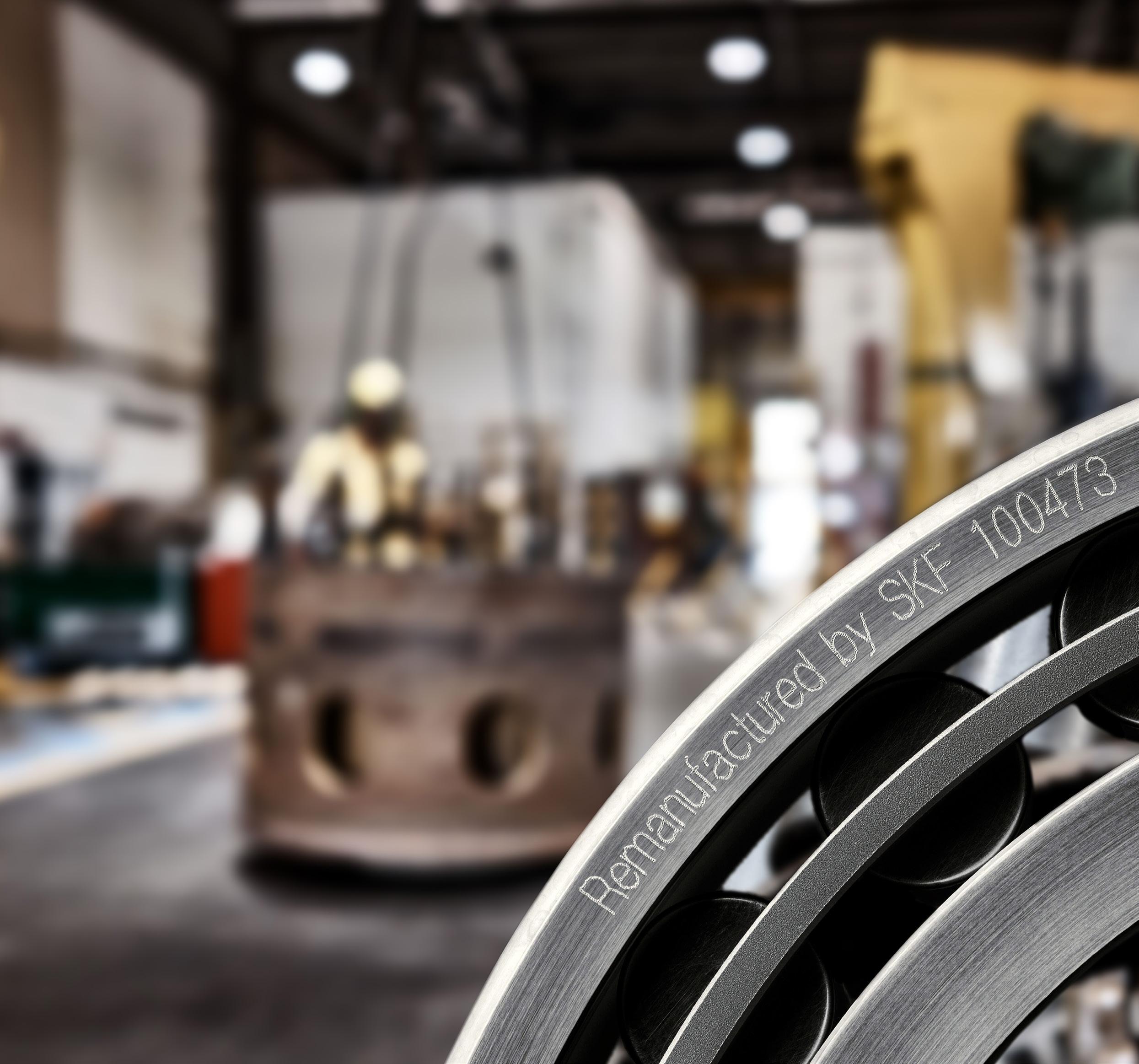
IN FOCUS
Issue 47
Reduce, reuse, recycle
the customer asked SKF to investigate the possibility and costs of remanufacturing all four.
Environmental and economic effects
All-round impacts
Manufacturing a new bearing has environmental and economic effects in a number of areas.
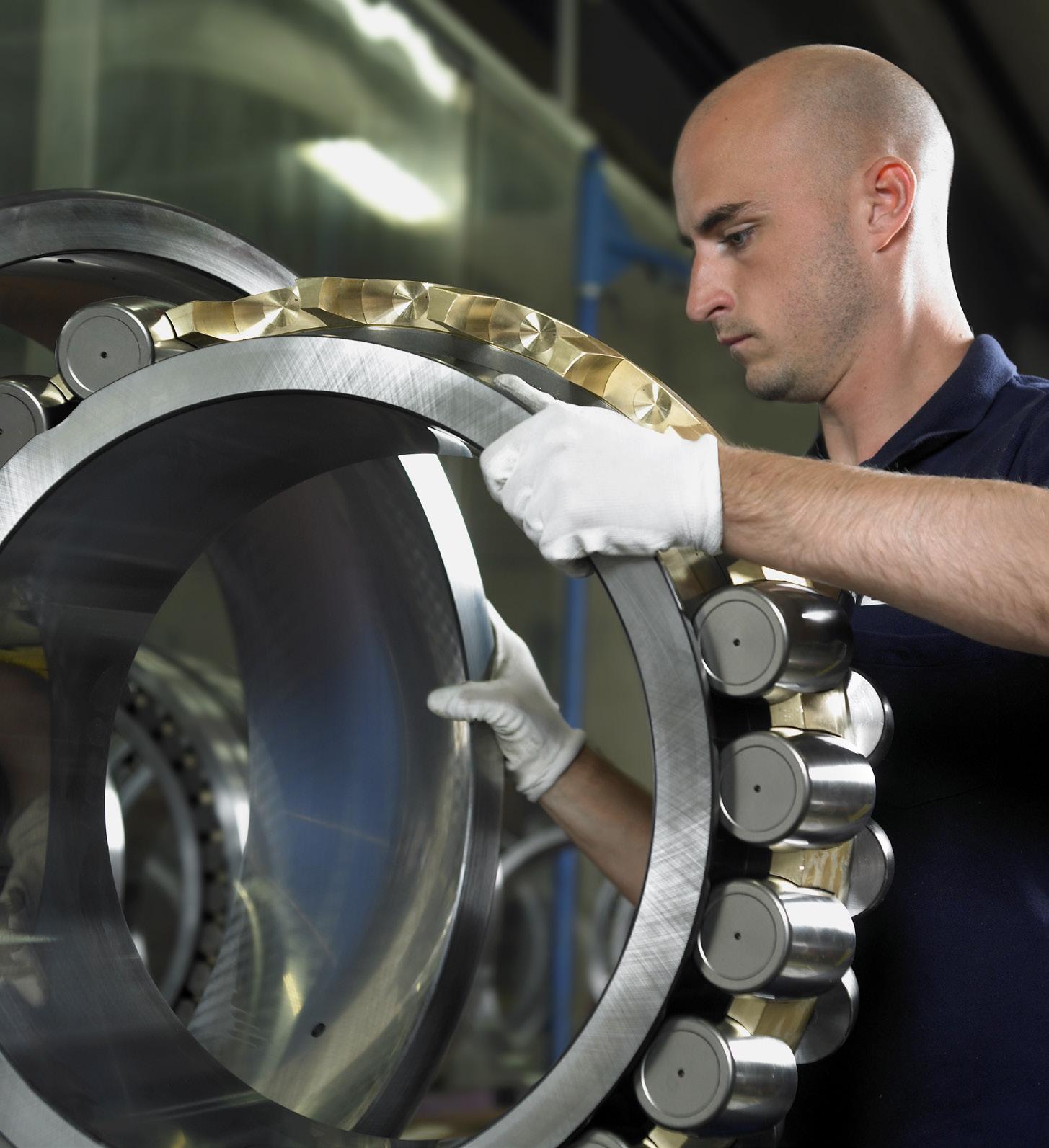
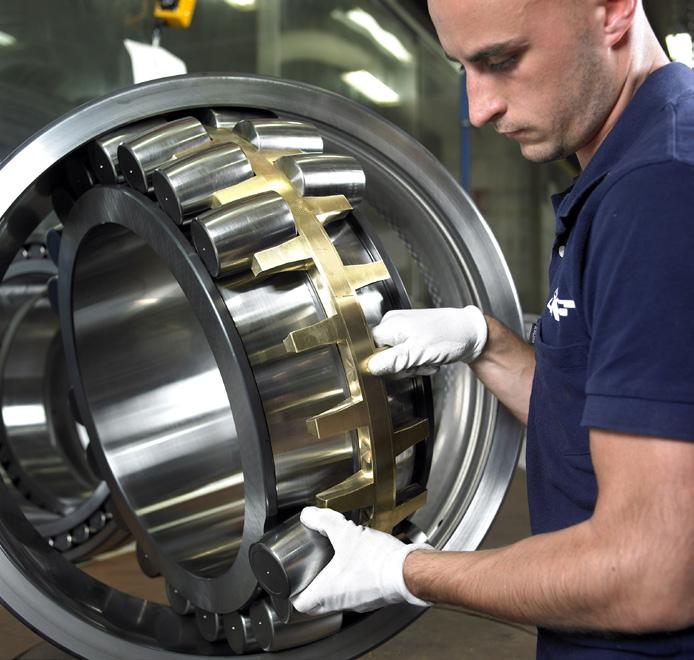
The raw material for the manufacture is steel, the production of which involves several finite resources. There are then further steps in the process from raw material to finished bearing – including forging, turning, heat treatment, grinding, honing and assembly.

Each one of these steps has an environmental impact, whether it relates to energy use, CO2 generation, material consumption or waste, or any combination of those.
Remanufacturing an existing bearing, on the other hand, involves far fewer steps. Which in turn means fewer negative environmental impacts: lower energy use, less CO2 generated, fewer materials consumed and therefore less waste produced.
As good as new –and better for the environment
The reduction in environmental impacts that result from remanufacturing is only one of the advantages compared with manufacturing a new bearing.
Remanufactured bearings have a shorter production lead time than new bearings. This can be critical if there is a risk of downtime and lost production should the original bearing catastrophically fail.
The carbon footprint of remanufacturing compared with making the same bearing from new is 90% smaller. And the cost of remanufacturing is also almost always lower – but without any compromise on quality.
For this particular SKF customer, as for many others, remanufacturing made perfect environmental and economic sense.
A perfect match
The bearings required were a large precision type, used in the customer’s press section in a paper machine. There were two of each type, with the C08 and VQ424 suffixes indicating that all four bearings have a reduced radial run-out.
SKF’s remanufacturing of the bearings maintained this particular feature, as well as restoring the bearings to as-new condition –for less than the cost of new manufacturing.
In addition, thanks to the SKF Avoided Emission Calculator, the customer could see exactly how much steel was re-used, how much energy use was avoided, and how many CO2 emissions were eliminated [see box-out below].
The figures were good on paper. And the bearings were good on recycled paper manufacturing too.
Reuse, recycle, result
The remanufacture of the bearings produced the following benefits for the customer and the environment.
2-off SKF 23096 CA/C08W77
Steel reused – 340kg
Energy use avoided – 2657kWH
CO2 emissions avoided – 1204kg
2-off SKF 239/750 CA/W33VQ424
Steel reused – 840kg
Energy use avoided – 5191kWH
CO2 emissions avoided – 2352kg
25
eriks.co.uk
Less than the cost of new manufacturing
Roll-up, roll-up!
(There’s more than that to hose management)
Sam Harper Hose Application Engineer

Managing your hoses means more than rolling them up at the end of the day. And not managing them can mean more than an untidy site. It can mean dangerous trip hazards, polluting leaks, and unnecessary maintenance and replacement costs.

IN FOCUS
Issue 47
Like most people, you’re probably not a hose expert. As long as your hoses are transporting liquids from one place to another, why would you even think about them? But in reality, that’s not the end of your hose management.
If you want hoses you can count on to be safe, reliable and cost-effective, you need to start by identifying what hoses you have. An ERIKS Hose Management Survey will tell you that – and much more.
ERIKS’ hose specialist engineers have surveyed sites where more than 1 in 10 of the hoses in use were wrongly described on the customer’s SAP system. Which means that when the time comes to replace them, a less experienced supplier who replaces like-forlike will also be replacing wrong-for-wrong. And, depending on what the hose was being used for, that means continuing all the associated risks of leaks, premature failure, and potential pollution or injury.
Leaks, premature failure, and potential pollution
Not knowing what hoses are on site and what applications they are being used for can also lead to unnecessary duplication of purchasing and inventory, and missed opportunities for cost savings.
Keeping tabs with tags
Once an ERIKS Hose Management Survey has identified the hoses, the results need to be recorded for future reference.
So ERIKS specialists attach tags to each hose, with a unique reference number and barcode.
It’s then possible simply to use any smartphone to identify the hose and check its specification, function, age, and replacement due date.
This information is essential for satisfying Health & Safety inspectors and insurers, whether during an audit, premium quotation, or – in the worst case scenario – during an accident investigation.
Hose housekeeping best practice
A written report is also provided, which not only identifies the hoses, but also makes recommendations for replacing unsuitable hoses, for rationalising the hose inventory, for inspection and testing regimes, for a replacement timetable, and for hose housekeeping best practice.
Right hose, right place
In one survey of a customer’s hoses, ERIKS’ specialists identified 23 different types of hose in use at one site. Using their knowledge of hose types and applications, they were able to rationalise the types of hoses in use, and reduce the number to just 7-types – with no reduction in hose efficiency or safety.
The customer was also able to simplify specifying and ordering, reduce the risk of using the wrong hose for the wrong application (also reducing the potential for leaks and bursts), and cut costs. And by identifying process critical hoses, and which hoses were used in the greatest numbers, ERIKS helped the customer to ensure they always had sufficient spares in stock.
More suitable hose solutions
In other cases, the ERIKS survey has helped customers to find more suitable hose solutions for specific applications.
For example, one customer had hoses which were dragged across the floor in daily use. To make this easier, the customer had specified lightweight hoses. But these tended to wear quickly due to their soft outer.
Rather than simply propose the obvious but unsatisfactory solution of a heavierweight hose, ERIKS specified a hose with a polypropylene spring along its length. This reduced abrasion, the risk of leaks and the need for more frequent replacement, without significantly increasing the weight or cost of the hose.
Easing the pressure
The risk of a hose leak or burst is always a concern. The more potentially polluting or toxic the liquid in the hose, or the greater the pressure it’s under, the greater the worry.
So rather than waiting until hoses fail, ERIKS’ scheduled hose testing provides proof and certification of their safety.
Pressure testing takes place on site, with water. ERIKS’ specialists take responsibility not only for certifying the hoses, but also for safe removal and disposal of the fluid originally in the hoses, and of the water used for testing – which may have become contaminated by the hose contents.

So whether you want to test, rationalise, or simply identify, an ERIKS Hose Management Survey will help you to get a grip of your hoses.

27
eriks.co.uk
Spills without the thrills
Skade Product Manager, MRO & Safety Equipment

You don’t have to be working with toxic chemicals or hazardous fluids for a spill or leak to be a problem. Even milk is an environmental hazard if it enters a watercourse in large enough volume. And just a small amount of any liquid, spilt on a factory floor, could create a serious slip hazard. So if you want to avoid the unwanted ‘thrills’ of fines for pollution, injured employees, and Health & Safety prosecutions, read on – as an ERIKS spill control expert spills the beans.
If you store or use fluids, a spill is almost inevitable. Most likely, it will be small-scale – when topping-up oil, or from a faulty lubricant seal, for example. If you have a lorry- or car-park on site, the spill could be as simple as oil dripped onto the ground from a leaky engine.

A spill is almost inevitable
But whatever the liquid, wherever the source, and however small or large the spill, you have legal obligations to manage it, clean it up, and dispose of the resulting waste. What’s your spill response?
The first response to a small-scale spill is usually ‘**!!@*!’.
A spill from a leaky machine may only constitute a slip hazard. So it could be quicker and less costly to contain and clean up than to fix at source, if that would require

IN FOCUS
Issue 47
Paul
production downtime. An easy-access, dedicated spill station, containing absorbents, will make it easier to prevent spillage from spreading, mitigate any slip hazard, and prevent possible pollution, environmental or other damage – not to mention making cleaning-up easier.

At the other end of the scale, a large volume toxic spill has the potential to cause enormous environmental pollution, and result in huge clean-up and rectification costs. In addition to reputational damage and associated loss of business.
To handle this size of spill effectively, you need an emergency spill kit that – like a fire extinguisher – is always ready for action but hopefully rarely used. You also need an effective and practical Spill Response Plan, tailored to suit your likely spill hazards, the environment where they may occur, and their potential scale.
Fail to plan. Plan to fail.
The most common ‘non-specialist’ fluid (i.e. not a process-specific chemical) stored in an industrial setting is likely to be oil. Government guidance sets storage regulations for the liquid [see box-out below] which are designed to prevent oil spills spreading.
One option is to use Spill Pallets from ERIKS. These not only help prevent pollution from spreading spilt oil, but are a highly sustainable solution themselves, manufactured from 100% recyclable plastic.
Causing environmental or other damage A
However, containment is only one aspect of a Spill Response Plan. A Plan also needs to include a strategy for dealing with spills, and should include a Kit Management Plan for selecting, purchasing and maintaining your spill control equipment.

Granules v Socks
Soaking-up spills the traditional way with sand or clay granules is ineffective, inefficient and – with the contaminated material going to landfill – unsustainable.
Instead, you can equip your Spill Response Kit with sustainable and spill-specific absorbents from ERIKS. Spill pads and rolls, and UK-made socks and pillows made from waste from
the trimming pads, can be selected to suit the fluid, the spill environment and the likely spill volume. They can also be incinerated as contaminated waste, rather than going to landfill.
With so many fluids, so many risks and so many options for effective spill response, what you need first of all is expert advice. ERIKS can arrange a site survey to identify and report on your spill risks, propose the most appropriate Spill Response Kit, suggest where it should be positioned, and help you prepare an effective Spill Response Plan. But don’t put it off until later. The only thing worse than a hazardous spill is a hazardous spill you could have controlled.
Catch it while you canGuide to UK Government Legislation
Government regulations state that an oil container must have secondary containment to catch any oil that leaks. This can be:
a drip tray underneath an outer case (bund) which holds the container
All fixed tanks must be bunded, and a bund must be capable of holding 110% of the container’s capacity.
highly sustainable solution
29 eriks.co.uk
Take control of linear motion and control energy use

Linear motion has traditionally been provided by pneumatic actuators. But recently, electric actuators have grown in popularity, thanks to their precision, flexibility and guaranteed repeatability. Now as energy costs soar and industry is searching for any possible way to reduce energy consumption, Norgren offers both pneumatic and electric options as potential energy-saving solutions.
If you want to entirely remove compressed air and the cost of its production from your application, there’s the Norgren ELION rod-style electric actuator. Or, if you wish to reduce the amount of compressed air used
in your application, there’s the Norgren IVAC (Integrated Valve And Cylinder) pneumatic cylinder.
Switch to which?
The Norgren ELION Electric Actuator range has a key advantage which makes it a convenient switching option for applications served by rod-style cylinders. The unit has been designed to conform closely to ISO dimensions which greatly aids interchangeability. So you can change from pneumatic to electric actuation with minimal cylinder footprint adjustment.
To help you choose the right option for your particular application, you need to consider the unique benefits each one offers.
However, if swapping to electric actuation is not an option, upgrading your pneumatic system to IVAC cylinders, you will benefit
IN FOCUS
If your production process involves linear motion control, there’s not just one easy answer for energy-saving. There are two easy answers. And both of them are provided by Norgren. Issue 47
The
right option for your application
from the integration of valve and cylinder –which reduces pipework, reduces wastage of air, and therefore reduces the amount of compressed air needed to be generated. Compared with your current pneumatic system, this can cut your energy consumption by as much as 50% – and in turn optimise the sustainability of your operations by shrinking your carbon footprint.
Both options are available in six sizes, ranging from 32-100mm cylinder diameter.
Reliability, repeatability, reduced energy
A pneumatic system uses the full air pressure supplied to the cylinder, even if it’s not all required for the application. This means that more energy than necessary may be consumed, to produce more compressed air than necessary, that ultimately goes to waste.
repeatability. For example, accuracies of +/0.02mm can be achieved, with a repeatability of +/- 0.01mm.
The long and the short
So as you face rising energy costs, Norgren gives you choices. Choices which will not only reduce your energy consumption, shrink your carbon footprint and increase the sustainability of your processes, but which could also optimise the efficiency of your linear motion control.

The reduced amount of air required also significantly reduces the cost per mm of stroke, meaning the air savings will effectively pay for replacing your current cylinders with IVAC alternatives.
High-efficiency, plus hygiene
There are two IVAC cylinder Options. The IVAC Cleanline is a smooth, Cleanline body profile cylinder, engineered to IP67 Protection Class, and is a hygienic design according to EN1672-2. Alternatively the IVAC Industrial variant has external switch mounts and is engineered to IP65 Protection Class.
An electric actuator such as the Norgren ELION, on the other hand, only uses the energy that’s required to move the load to its required position, and then to keep it there. And if a holding brake is fitted and applied, then the load can be held in position with no energy consumption whatsoever.
The result is less power consumption, lower energy costs, and a smaller carbon footprint than a comparable pneumatic system.

To help you choose the route to follow, there’s a simple rule of thumb. The greater the size of the cylinder in your application, the greater the saving you will make by switching from pneumatic to electrical actuation.
However, for a more customised and considered review, and more expert knowhow to aid your decision-making, just go straight to your usual ERIKS representative.
Why would you waste your energy going anywhere else?
The Norgren ELION can also provide unmatched performance in precision control of speed, position, accuracy and
31 eriks.co.uk Cut your energy consumption by as much as 50%
Smaller carbon footprint
How your electricity bill can save you money

 Dave Wilson Power Quality Solutions Manager
Dave Wilson Power Quality Solutions Manager
The power factor is the ratio of the ‘real power’ (the capacity of electricity for performing work) to the apparent power flowing in the circuit. And if the apparent power is greater than the real power, more current flows in the circuit than you actually need.
A low power factor will draw more current than a high one, but only provide you with the same amount of real, ‘working’ electricity. This means more wasted energy, higher energy costs, and a bigger carbon footprint. So one of the simplest ways to reduce energy use and waste, and shrink your electricity bill and carbon footprint, is Power Factor Correction – with a Return on Investment expected within three years.
Losing on penalties
If your site’s power factor needs correcting, you’re not only paying for energy you don’t really need. You are also likely to be charged financial penalties by your electricity provider.

Firstly, if your site’s power factor is less than an average of 1.95, a Reactive Power Charge
will be added to your bill. Secondly, if your site is making a high kVA demand, you are at risk of exceeding your authorised limits. If you do, you will be charged up to three times more for every kVA unit.
Power Factor Correction will reduce your kVA demand and help to ensure you don’t exceed the limits. And the money saved
ROI expected within three years IN FOCUS
To save money on your energy, all you need is your utility bill and a conversation with your ERIKS Service Centre. That’s how to identify whether your business would benefit from Power Factor Correction – with lower costs, greater power stability, reduced maintenance, and a reduction in CO2 emissions
Issue 47
by avoiding penalties is in addition to the amount saved by simply using less energy more efficiently.
Money saved by avoiding penalties
5-star electricity
All power is not the same.
While Power Factor Correction is helping to reduce the amount of current being drawn, it is also improving the stability and quality of that power. This in turn has the effect of reducing maintenance for electricallypowered equipment.
Reducing maintenance for electricallypowered equipment

Devices available to reduce KWh have the unwanted side-effect of introducing harmonics. Harmonics then have to be mitigated by fitting filters to individual machines – at an additional cost. As an alternative, by improving power quality, Power Factor Correction eliminates harmonics too.
Where to start saving
Energy bills from many providers contain enough information to identify if there is potential to make savings. Half-hourly energy use data from the metering provider will supply more detail, making it possible to assess what kind of correction is required. A site visit by ERIKS Experts and our partner suppliers will identify the most effective location for installation of correction equipment, before development of a specification, a calculation of costs, and a prediction of savings.
Decide to go ahead, and a simple retrofitted three-phase system will get Power Factor Correction up-and-running with just a brief power interruption for installation. Co-ordinate this with a planned shutdown (a half-day), and you can start saving on your bills and reducing your carbon footprint immediately, without disruption to production.
So the best places to start looking for energy and emissions savings from Power Factor Correction are your utility bill and your local ERIKS Service Centre.
Case Study

The monthly electricity account of a medium-size industrial manufacturing plant showed the site’s maximum demand load was 0.78 PF. This attracted a Reactive Power Charge of £53.48p.m. / £641.75p.a. (incurred when the average power factor drops below 0.95 lagging). When Power Factor Correction improved the load to 0.98 PF lagging, the charge was eliminated.

At the same time, reducing the agreed supply capacity by 100kVA @ £1.46807/ kVA x 12 months saved a further £1,761.68. More investigations indicated that the site’s agreed supply capacity was 700kVA, but maximum demand was only 542.4kVA. Improving the Power Factor enabled a reduction in kVA demand to 433kVA, saving an additional £1,761.68p.a.
So the total annual saving to the customer through the introduction of Power Factor Correction was:
Eliminated Reactive Power Charge £ 641.76
Reduced agreed supply capacity £1,761.68
Reduced kVA demand £1,761.68
Total saving: £4,165.12
33 eriks.co.uk
Don’t get caught in the steam trap
The rising price of energy has increased the cost of generating a tonne of steam, from around £20/tonne twelve months ago, to £40 - 50 today.
On average, 15 - 20% of steam traps in a steam system will be in failure mode at any one time. They may be jammed open, closed, or leaking steam.
One failed steam trap will waste up to £2,000 worth of steam per year.

A 1mm hole in a steam line will waste £500 of steam per year.
A leaking 2” isolation valve will lose steam to the value of £750/year.


ERIKS Flow Control specialists identified a steam trap failure rate of 57% on one steam system surveyed.
So, it looks like steam is more than just a lot of hot water. And talk about the cost is not just a lot of hot air. With energy prices rising – and energy use directly reflected in the size of your carbon footprint – all businesses want to save energy, save money and be more sustainable.
Which means now is the time to find ways to produce steam more cost-effectively, use it more efficiently and shrink the size of your next energy bill.
Survey, safety, and savings
Steam is not only expensive. It can also be dangerous. So, Health and Safety considerations come before cost, but the two go hand-in-hand.
Leaking pipes or jammed valves – which waste energy and money – can also allow
15-20% of steam traps in a system will be in failure mode
IN FOCUS If you’ve never worried too much before about the cost of producing steam for your processes, here are some scary steam statistics to get you thinking.
Shrink the size of your next energy bill
Issue 47
Bill Gibson Technical Manager, Valves & Steam
scalding hot steam to escape, and risk injuring anyone in the vicinity.
To comply with Health and Safety regulations, every system containing steam at pressure must be regularly inspected. An ERIKS Steam Trap Survey will not only identify issues which are a safety risk, but also those which are reducing efficiency and increasing costs.
Returns on return
With your steam system surveyed and any maintenance issues resolved, ERIKS Flow Control specialists can also help you identify more ways to save money. One of the simplest is to ensure the system returns condensate to the boiler.
Raising cold water above 100°C to produce steam consumes a large amount of expensive energy.
In fact, to raise a tonne of cold water to the required steam temperature costs around £46. But if condensate is captured and returned to the boiler, the water temperature will be maintained at a higher level, so it takes less time and energy to achieve the required steam temperature for steam production once again.
Recovering flash steam is another way to recoup the cost of steam generation. When condensate is discharged via steam traps, from high to low pressure, some of the condensate (typically 10-15%) evaporates into flash steam. This contains heat energy which will be wasted unless recovered.
Incorporating flash steam recovery into a steam system can provide a return on investment within as little as 6 months.
Taking back control
Once you have done everything you can to avoid wasting steam that’s already been produced, there’s still more you can do to produce the steam more efficiently in the first place.
Simple on/off control of the gas or oil burners heating the boiler is crude and costly. But modulated burner controls allow far greater flexibility and enable far more efficiency.
Variable speed pumps are also more costeffective than those which are either on or off. They can modulate their operation to match the amount of boiler feedwater required, saving energy, and eliminating the need for boiler feedwater control valves.
And variable speed controls on cooling fans can also help ensure the most efficient use of energy.
Hot stuff
Steam is to hot water what flow control is to daily engineering maintenance. In other words, more complex and specialist than you may imagine.
Complex and specialist
That’s why you need Flow Control specialists like ERIKS to regularly inspect your pressurised steam system for Health & Safety compliance, to provide scheduled maintenance, and to identify and implement effective cost-saving measures.
Because losing steam from your system doesn’t only mean lost steam. It means lost energy, lost money and lost production.

35 eriks.co.uk
When water and oil do mix
It wasn’t the waters that were troubled at a UK water business. It was the maintenance engineers. But pouring the right oil onto the problem could still help.
The engineers were watching millions of pounds being spent annually on energy, to power motor and gearbox drives at their water treatment plants. What they wanted was a lifebelt to save money from going down the drain. And they got one, in the form of a unique Rocol service to help them find the solution.
A unique Rocol service
As a leading supplier of specialist lubricants for industry, Rocol has decades of experience in matching the lubricant to the application. And a comprehensive range of technically advanced specialist industrial lubricants to choose from, to ensure customers get the performance they want, and can rely on, whatever their lubrication requirement.

What the water business wanted was an energy-saving solution which could help to reduce their six figure annual electricity bill, without compromising asset reliability. Finding the solution began with Rocol’s unique six-month comparative trial.
Trial and aeration
The customer’s main area of energy consumption was the drives for motors and gearboxes for the waste water aeration tanks. So when Rocol proposed a comparative trial of lubricants from four different companies, these were the ideal assets to put the oils to the test.
Firstly, the energy consumption of each gearbox was monitored and recorded for a set period, to provide baseline data. Then each lubricant manufacturer involved was provided with six identical aeration tank drive gearboxes, for the six-month lubricant trial.

IN FOCUS
Issue 47
These trials are frequently offered by Rocol, as a way of proving to potential customers that it’s not always the figure on the lubricant price tag that’s the most important. A lubricant that looks cheaper in the short-term may prove to be more expensive in the longerterm, if it reduces efficiency, increases energy consumption, or even increases maintenance costs and shortens asset service life.
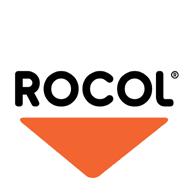
Talking the torque
The lubricant proposed for the trial by Rocol was SAPPHIRE Hi-Torque. This range of highperformance, semi-synthetic gearbox fluids is formulated to minimise wear, reduce the risk of breakdown and significantly extend gearbox life.
is effective throughout extended relubrication intervals – helping to noticeably reduce lubricant use.

Oil in all
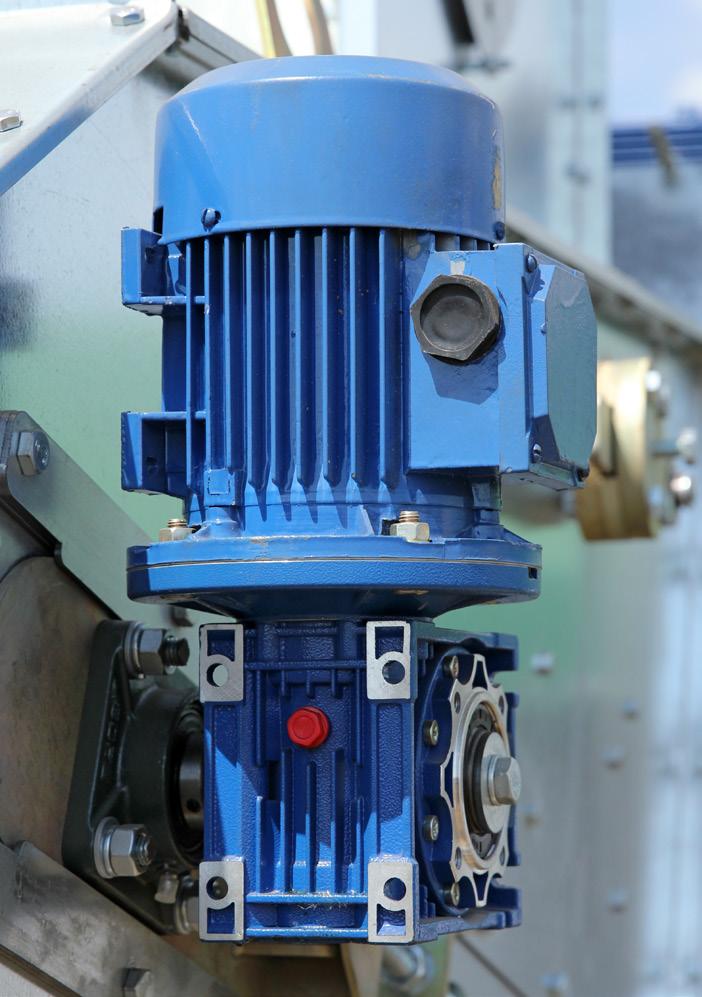
The results of the trial proved so successful that the customer decided to roll-out the chosen oil not just for use in the aeration tank drive gearboxes, but in all gearboxes across all their eight sites.
And the oil they chose? Rocol SAPPHIRE HiTorque, of course.
Among the benefits of SAPPHIRE Hi-Torque is its wide temperature resistance, from -20°C to +120°C. It also has outstanding EP performance (with a 560kg weld load), and provides excellent thermal stability. SAPPHIRE Hi-Torque also incorporates the Start Up Protection System unique to Rocol lubricants, which offers maximum protection. Creating a tenacious and low-foaming film – with excellent resistance to water wash-off – and protecting against corrosion, Rocol SAPPHIRE Hi-Torque’s semi-synthetic formulation makes it compatible with most types of mineral and synthetic oils. Dyed blue for visibility, and with a high level of stability, it
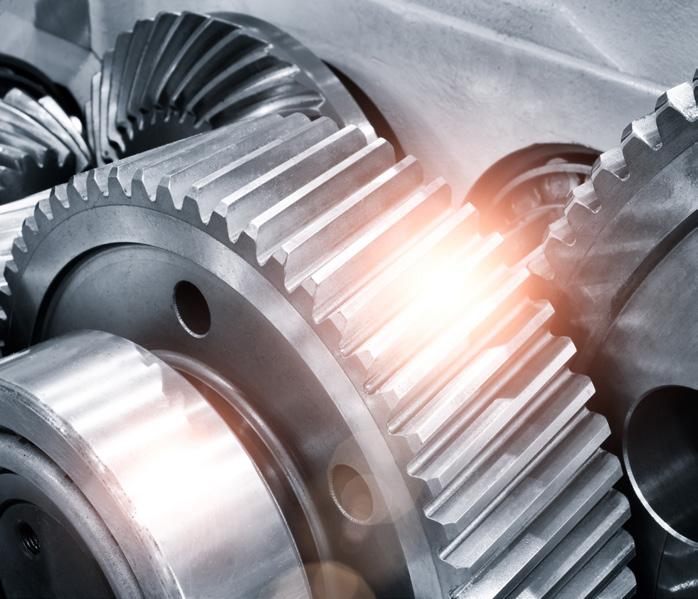
The trial showed that after six months, SAPPHIRE Hi-Torque saved over 4% of energy consumption, compared with the oil previously used by the customer. Across the customer’s eight sites and previous total energy cost of £477,800, that equates to a cost saving of £19,140.
Although the savings were realised through the premium quality of Rocol SAPPHIRE Hi-Torque, the experience of Rocol’s service engineers also played a part.
By carrying out the installation of the oil for the customer, they ensured that exactly the right amount was used for each application. This avoided both under-lubrication and possible asset wear, and over-lubrication and oil wastage. And it provided the most efficient lubrication for optimum asset performance and maximum energy cost saving.
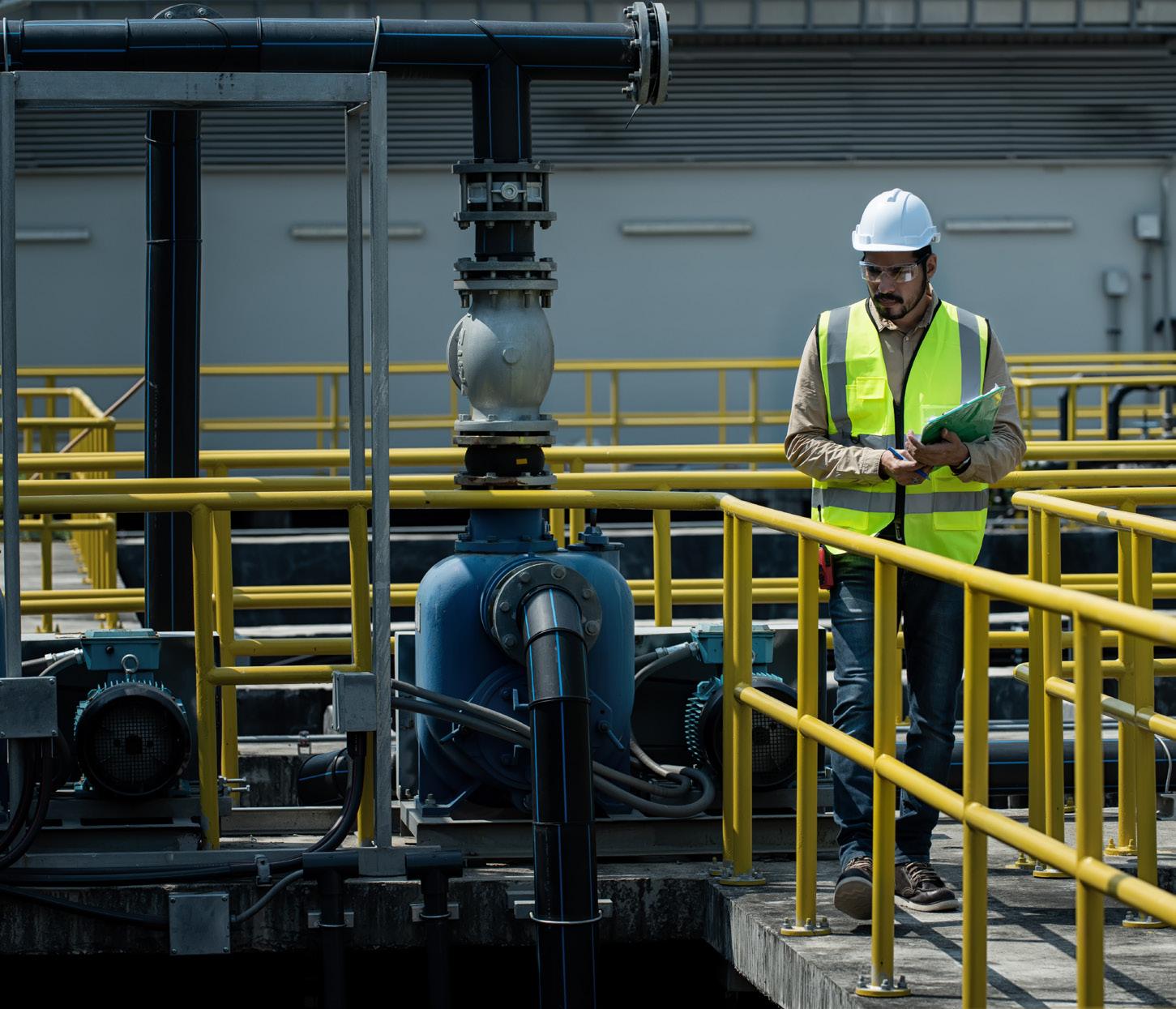
like water
37 Saving
Rocol SAPPHIRE Hi-Torque gearbox oil helped the water business to realise significant energy cost-savings across their eight sites. SITE TOTAL ENERGY COST SAVING (4%) 1 £14,200 £570 2 £32,300 £1,300 3 £41,400 £1,700 4 £186,300 £7,500 5 £110,600 £4,400 6 £16,800 £670 7 £55,400 £2,200 8 £20,800 £800 £477,800 £19,140 eriks.co.uk Saved over 4% of energy consumption Benefits of SAPPHIRE Hi-Torque
money
Why lubrication is worth looking into
Charles Flint Food Industry & MRO Sector Specialist

A lubricants survey conducted by Moove and ERIKS is a comprehensive review of lubricants and lubrication practices, to identify what is being done right, and what could be done better. The survey considers a whole range of categories: from lubricant storage and handling to health and safety, and from lubricant selection, analysis and usage to contamination control and training.
Once the results have been gathered and assessed, the survey will identify the steps needed to implement a lubrication programme which will optimise reliability, and deliver increased sustainability and reduced energy use wherever possible.
Storing-up trouble

A recent site evaluation for a manufacturer of cereal-based products delivered an initial site rating of ‘Poor’, due to a number of issues with oil storage, oil handling, and asset lubrication. The survey not only identified the issues, but also proposed solutions which would help the customer to realise
lubrication efficiencies and savings in the short- and long-term.

Meanwhile, in the storage area, First In First Out best practice was not being followed. Older stocks of grease and oils were being left to go out of date. Lubricants which are out-of-date will not perform at the level for which they are formulated, and asset efficiency and reliability will suffer as a result.

Moving onto the shopfloor, the lubrication experts from Moove noted that many of the gearboxes were located behind guards and screens. Before lubricant levels could be checked, the asset had to be isolated and the screen or guard opened for access. This meant excessive machine downtime, lost production, and increased labour costs for maintenance.
It was also discovered that the drive chains from the gearboxes were being manually lubricated with a grease not specifically formulated as a chain lubricant – reducing the effectiveness of the lubrication of the chains’ pins and linkages.
What’s in a name?
Inspection of several assets on the site revealed that their lubricant labelling was out of date or simply wrong.
Beginning with the oil stores and waste oil area, the survey revealed that poor signage on the waste oil bin posed a small risk of waste oil being mistakenly used again, with the associated risk of asset contamination and premature failure.
For example, some labels specified discontinued products, while others failed to provide enough information – making it too easy to mistakenly use the wrong product. If, for example, non-food safe lubrication was used where food-safe was required, this would obviously breach Health & Safety protocols.
IN FOCUS
Comprehensive review of lubricants and lubrication practices Realise lubrication efficiencies and savings
can do much more than just keep moving parts running
correctly, it can not only improve plant efficiency and reliability but also save energy.
to assess how lubricants are currently being used in your plant. Are they the right ones for the application? Are there more appropriate formulations? Or are there ways to use lubricants more effectively, to enhance sustainability and reduce costs?
help you find the answers. Issue 47
Lubrication
smoothly. Used
The key is
Together, Moove and ERIKS can
And even if the correct type of grease is used, mixing greases with different characteristics can lead to performance drops and premature bearing failure.
Gone missing
Some other assets inspected – such as Glycol pumps and mixer sets – required lubrication of their bearings or gearboxes. Yet there was no suitable motor grease or gearbox oil identified on site. Was there no lubrication being carried out – definitely leading to premature asset failure?


Or was the wrong type of lubricant being used – meaning less effective lubrication, and a shortened asset life?

The last aspect of the survey was a thermal imaging report. This identified the hottestrunning lubricated components, and enabled the recommendation of suitable highperformance greases capable of coping with the temperatures.
Moove-ing on
Having identified the problems Moove proposed a number of solutions, including: redesigning the stores; colour-coding lubrication points; installing sightglasses for critical assets in enclosed operating environments; conducting regular oil analysis to verify whether the best oil for the application is being used.
In some gear applications, simply changing from a mineral to a synthetic oil can deliver energy savings of up to 3.6% in gearboxes, and 6% in hydraulic pumps, through overall efficiency improvements. Which proves that when your assets and their lubricants work as well together as Moove and ERIKS do, there are real rewards to be had.
Energy
39
eriks.co.uk
savings of up to 6%
How to align cost savings with sustainability
 Dennis Briggs-Price UK Aftermarket Field Sales Manager
Dennis Briggs-Price UK Aftermarket Field Sales Manager

Businesses
Operating correctly aligned machines with the most energy-efficient bearing solutions can reduce running costs, and shrink energy bills. Yet research suggests over 50% of machines and industrial equipment are currently running out of alignment.
Misalignment typically occurs when coupled shafts are positioned so that their gaps or offsets are beyond acceptable limits. The consequence is that shafts run off-centre –causing high loads, generating excessive heat, and leading to greater energy consumption.
But there’s no need to wait for the next energy bill to reveal if misalignment is occurring
Signs might include increased temperature, high vibration, loose coupling bolts, or excessive lubricant leakage at bearing seals. Machines or systems showing these symptoms will almost certainly be using more power than if they were aligned correctly and running efficiently.
And with the right tools, correct alignment is easy.
Up to 17% savings
Users of NSK’s advanced laser alignment tools for shafts and belts have identified energy savings of up to 17%.
And correct alignment not only cuts power consumption but also reduces wear on important machine components like seals and couplings. This minimises machine downtime and maximises throughput in turn.

With NSK’s laser alignment tools, achieving perfect alignment is quick and easy – just like the ROI that results.
Be a carbon-zero hero

As industry tries to reduce its energy costs, it’s also striving for net-zero carbon emissions.
And with electric motors and associated systems accounting for more than 40% of global electricity consumption, they’re an obvious target for some fairly easy wins.
The wide range of energy-efficient bearings available from NSK not only saves money –
by reducing machine running costs – but also cuts CO2 emissions and contributes to more sustainable industrial operations.
More sustainable industrial operations
The NSK series of deep groove ball bearings, for example, generates up to 80% less energy loss when deployed in electric motors. Compared with conventional deep
IN FOCUS
Correct alignment is easy
are facing a tough choice. Do they swallow rising energy prices themselves, or pass on the cost to customers? There’s no easy answer, but there is a way to ease the pain.
Issue 47
groove products, these high-efficiency bearings produce 60% less friction with a steel cage, and 80% less with a plastic one.
NSK’s EA7 grease also increases energyefficiency, by reducing internal friction. At the same time, it doubles the service interval of electric motors, and provides enhanced lubricating properties when micro-vibrations are present. Alongside optimised grease fill, this low-viscosity, friction-reduced lubricant provides the ideal solution for any manufacturer wanting to reduce torque, minimise power loss and cut carbon emissions.
Based on concepts such as optimised raceway geometry and special sealing, NSK has also developed several series of bearings that deliver significantly lower friction characteristics.
These low-friction bearings can provide significant benefits in, for example, the automotive industry, where OEMs are seeking energy-efficiency gains from on-vehicle drive mechanisms. In other sectors (such as washing machine production) a favourable efficiency class often leads to higher sales – and this type of bearing also reduces operational noise and heat generation, which helps to extend service life.


Innovation in a bearing
The innovative technology of many NSK bearings makes them the perfect fit for innovative industry sectors, such as electric vehicle manufacture.

cage. Designed for use in air conditioner fan motors, it helps reduce plastic use and power consumption.
It’s this kind of environmental and sustainability initiative which helps industry to be green – and helps businesses to keep their bottom line black.
Look: don’t touch
Engineers designing energy-efficiency drive systems should always look closely at rolling bearings. That’s because it’s all too easy to compromise drive efficiency, through the friction inherent in conventional seal contact.
NSK’s non-contact seal technology products, on the other hand, ensure efficient sealing without increasing frictional torque or operating temperatures.
NSK’s pioneering plastic bearing cage improves the high-speed rotational performance of electric vehicle motors. The cage’s lighter weight – compared with a steel version – means reduced mechanical losses. In addition, it has excellent self-lubricating properties and a low co-efficient of friction. All these factors together contribute to energy efficiency and sustainability.
NSK has also developed the world’s first bearing with a 100% plant-derived bioplastic
41
eriks.co.uk
Minimise power loss and cut carbon emissions
Where sustainability goes hand-in-hand with safety gloves

 Jemma Potter Key Accounts Specialist, EMEA Industrial Sales, Mature Market Regional Sales UK
Jemma Potter Key Accounts Specialist, EMEA Industrial Sales, Mature Market Regional Sales UK
What would you expect the priority to be for a world-leading company in the safety industry? Safety, of course. But at Ansell, safety goes hand-in-hand with sustainability. The company has recently refined its sustainability efforts to align with the Sustainable Development Goals (SDGs) established by the United Nations. By prioritising the three environment-related SDGs most aligned to the business (Clean Water and Sanitisation, Affordable and Clean Energy, and Responsible Consumption and Production), Ansell aims to reduce its environmental impact without compromising product performance.
result from responsible manufacturing and enhancing the sustainability of manufacturing plants: using green energy, conserving water and reducing waste to landfill.
Over the past year, Ansell has invested in refining manufacturing processes, particularly in its Portugal plant.
scope 1 and 2 emissions inventory of the facility.
At the same time, the in-house water treatment plant has been expanded, and a reverse osmosis-based water recycling system installed. Now that all wastewater can be processed, there has been a 55% reduction in water withdrawal.
As a manufacturer of safety gloves, Ansell is well aware that the majority of a glove’s carbon footprint comes from manufacturing, and the smallest impact from end-of-life glove and packaging waste. So the greatest positive impact on the environment can
Thanks to the installation of solar panels, and a Green Power Purchase Agreement with Energias de Portugal, 100% of the electricity consumed at Ansell Portugal is now from renewable sources. These actions have reduced the facility’s greenhouse gas emissions by 900mt CO2e (compared with FY18) – representing a 37% reduction of the
Ansell’s Portugal plant is also playing a part in the continuing expansion of the company’s range of ‘Made in EU’ products. This helps to reduce the amount of transportation required, while dual sources of supply help mitigate the risk of unforeseen interruptions, and improve time-to-market in Europe.
IN FOCUS
Without compromising product performance
Issue 47
Slimmed-down waste
Ansell’s investment in a new dipping line is clear proof that safety and sustainability can work together.
The line, used for the application of the Ansell patented FORTIX™ technology, produces new and improved FORTIX™ products incorporating a breathable, ultra-thin nitrile foam coating for knitted gloves. This not only enhances their abrasion resistance but also lengthens their life – helping to reduce waste.
Reducing waste, eliminating plastic and minimising environmental impacts are also the reasons behind changes to the packaging of Ansell HyFlex® gloves.
Reducing waste, eliminating plastic

Previously packaged 12 pairs at a time, using a paper insert covered in a plastic film, one shipper case configuration of 144 pairs of gloves represented an average of 102g of plastic and 239g of paper packaging. Since March 2022, plastic-free packaging on a range of industrial gloves has introduced a newly-designed paper band to replace the previous paper and plastic band.
The new band is fully recyclable, made of responsibly sourced and certified paper, and contains 100% post-consumer recycled content.

A big hand for green gloves
The HyFlex® 11-840 glove has long been Ansell’s most popular multi-purpose glove. Now the HyFlex® 11-842 version deserves a round of applause for going green.
Sustainable design features include 90% recycled nylon yarn* liners, plastic-free inner packaging containing 53% fewer materials**, and a carbon footprint reduction of 75g CO2eq per pair^. They are also non-latex, and Dermatest® dermatologically tested to guarantee they are free from harmful substances.
The resilient polymer formulation in the coating, together with the new and improved FORTIX™ technology, provides an extended working life, enhanced durability, and superior fit for precision handling. There’s also up to 20% greater abrasion resistance^^ for workers in a wide range of applications. The touchscreen-
compatible gloves are equipped with ZONZ™ Comfort Fit technology, to help improve breathability and dexterity, provide all-day comfort, and reduce the need to remove them when switching between tasks.
The HyFlex® 11-842 is also food-approved, silicone-free and OEKO-TEX® Certified. Making it an excellent universal working glove that not only protects workers, but the environment too.


* minimum recycled content of more than 30% in the final product (based on size 9)
** vs. standard nylon multi-purpose gloves
^ 71% less greenhouse gas emissions – Ansell’s LCA, calculated as weight reduction, peer reviewed
^^ vs. previous technology version
Made sustainably using recycled yarns, and packaged sustainably using responsiblysourced and 100% recycled paper, the HyFlex® 11-842 sets a new benchmark for sustainable PPE solutions.
43
A new benchmark
eriks.co.uk
CUSTOMER BENEFITS ENVIRONMENTAL BENEFITS
A brewer chills out over costs and reliability
 Greg Wainhouse Industry Account Manager, Water
Greg Wainhouse Industry Account Manager, Water

Increased demand for craft beers meant a brewery needed to install new chilled storage tanks, just as the pipework and control valves on its existing tanks were reaching the end of their service life. This left the production engineers with a requirement for no fewer than 84 control valves. Which initially threatened to leave them with a very large bill.
Having previously relied on electronicallyactuated control valves, the engineers sought like-for-like quotes. But rather than simply quoting and sitting back, Bürkert arranged a site visit to assess the requirement at first hand.
Mixed messages
The valves are used to control a water/ glycol mix which cools the storage tanks. As they are part of a hygienic process, they need to be manufactured in stainless steel. And adding further to the cost is the size of the threaded connecting pipework, at 50mm/2ins diameter.
Although a premium price seemed unavoidable, Bürkert felt sure they could offer a more cost-effective solution.

The site visit revealed that the engineers had specified electrical actuation because of ‘the high cost of pneumatic controls.’ This perception was based on one recent quote from a different process control manufacturer. After reviewing and assessing the existing system, Bürkert’s engineers explained how all the aims of the process could actually be achieved using pneumatic valve islands and control valves.
And at a significant saving over an electricallyactuated system.
IN FOCUS
solution
Cost-effective
When ageing equipment needs replacing, or a production line needs expanding, doing nothing is not an option. That doesn’t mean considerations of cost-effectiveness, reliability and total cost of ownership (TCO) can be put to one side. It’s actually the perfect opportunity to investigate new technologies, with a view to improving productivity and reducing costs – as
Issue 47
Bürkert proved for one of the UK’s leading brewers.
Forward thinking
Bürkert’s proposed solution wasn’t designed to deliver just short-term benefits, but also long-term TCO and reliability advantages.
The company’s latest valve island – the Type 8652 – built into a European Hygienic Engineering and Design Group panel, could be positioned close to the process, to reduce installation complexity and cost.

Saving over an electricallyactuated system
While the compact size of the valve island has space-saving benefits, in this case the customer wanted a larger panel, to futureproof against expansion of the system and allow for their own input/output systems. So Bürkert populated all the valve island control modules, leaving the unused ones to easily be connected as and when the application expands.

The control panel was custom-built by Bürkert, and designed to accommodate the installation of the Type 8652 AirLINE, which is optimised for installation at the bottom of the panel.
The choice of positions for the air supply port on the valve island meant the air preparation unit (filter and regulator) could also be included within the panel, with no need for additional connection points. Placing this unit outside the panel is the more conventional option, but Bürkert’s solution provided protection against water ingress during washdowns.
The last pieces in the system jigsaw were the Type 2000 valves, in stainless steel with threaded connections. These were each fitted with a CLASSIC actuator. Although the customer opted for hardwiring rather than gateway connectivity direct to the Rockwell PLC, the amount of wiring – and therefore its cost – was still significantly reduced over the electrical solenoid valve option.
Status symbol

Along with the lower cost of the pneumatic package, the Bürkert system helps reduce the TCO with a handy status monitoring feature.
A back-lit LCD screen integrated into the valve island displays pilot valve status, process valve switching status, a switching cycle counter and a diagnostic report. This instant status information for remote components and connections accelerates and simplifies fault diagnosis – making it easier to maintain performance, optimise efficiency, and manage operational maintenance.
Status monitoring feature
With the system fully operational, the customer’s Project Manager reported that ‘the increased functionality means we can reduce the amount of cooling and have greater control over the whole process. We have also made some very significant savings in terms of installation time and overall plant running costs.’
Not surprisingly, the brewery then decided it was time to get another round in. Of 20 more Type 2000 valves and an additional valve island.
45
eriks.co.uk
Protecting your bearing investment

Large industrial bearings are a significant capital investment. So it’s essential to maximise their performance. These five Best Practice tips from Timken will help you do just that – while increasing your plant’s uptime, and without breaking the bank.

1 – Select the right bearings
Bearing selection depends on the application, and mechanical and environmental factors.
Each roller element type (ball, needle, cylindrical, spherical or tapered), has design-specific characteristics for load, speed, stiffness or allowable deflection, lubrication requirements, static and dynamic misalignment, and desired service life or durability.
Bearings cope with a broad range of speeds and many combinations of radial and axial loads, but environmental operating conditions (temperature, dust, dirt, moisture, unusual mounting conditions) can affect performance.
Bearing envelope size constraints – such as minimum shaft diameter, maximum housing bore and available width in the bearing application – will also affect the bearing choice.
Several bearings with different load-carrying capacities may fit in the envelope. However, which of these will deliver the desired predicted service life can be identified through a bearing-system-life analysis carried out by the bearing manufacturer.
The final step is to define the bearing design options and select the most appropriate. The options are cage type, bearing flange configurations (for cylindrical and tapered roller bearings), radial internal clearance (RIC) or setting, precision level and lubrication.
Selected based on the application’s speed, temperature, mounting and loading conditions, correct choices will help optimise bearing performance and life.
Cleaning: After removal and before inspection, bearings (including all internal rolling elements) should be thoroughly cleaned to remove water, lubricant, debris and other contaminants. Always follow the manufacturer’s cleaning recommendations.
2 – Follow proper handling practices
How bearings are stored, removed, cleaned, inspected and installed will vary by bearing type. However, general good practice includes:
Storage: In original packaging on a pallet or shelf until ready for use. Even small amounts of moisture can initiate bearing fatigue, so avoid high humidity or widely variable temperature environments where condensation may form.
Handling: Avoid bearing damage during removal and installation, through use of the correct tools. Pullers and installation tools are available for smaller bearings, while larger bearings require slings, hooks, chains and mechanical devices. The right tools will also help prevent costly or irreparable bearing deformation.
Inspection: Damage and wear inspection should also include measuring the bearing, to ensure it is within the application’s tolerance specifications. In some applications, expected bearing life may be the limiting factor in the equipment maintenance schedule. Routine inspection and measurement will reveal problems and enable correction before they lead to equipment downtime.
MAKING INDUSTRY WORK BETTER
Optimise bearing performance and life
Issue 47
3 – Optimise your predictive maintenance program

Predictive maintenance can improve uptime by warning of potential problems while the equipment is in operation. Condition monitoring systems can – for example –detect and monitor excessive equipment temperature or vibration, and report them in real-time. Remote Monitoring Services provide continuous predictive monitoring by collecting data, which can be analysed to identify process improvements.
The correct lubricant for each application depends on the bearing design and operating conditions. In general, lubricants are classified as oil or grease, with different benefits.

5 – Repair bearings to extend service life
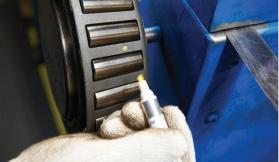


Damaged or out-of-specification bearings may be returned to service after repair or refurbishment. Some can be refurbished more than once.

Analysis can help identify possible causes of damage, and solutions to help ensure longer life for the replacement bearing. Minor damage can often be repaired on site by maintenance engineers, though remanufacturing services from bearing specialists will be required in cases of more serious damage.
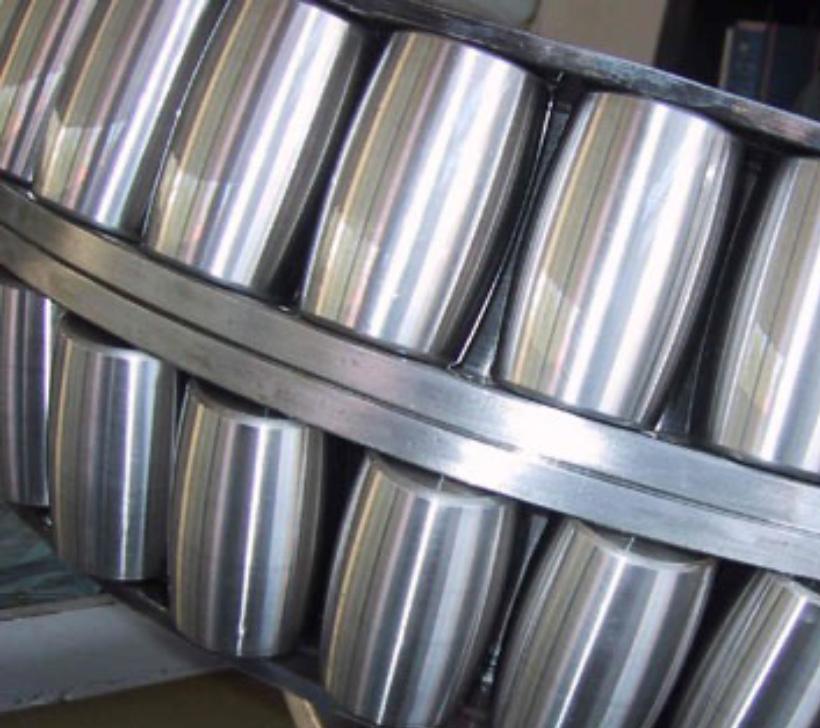
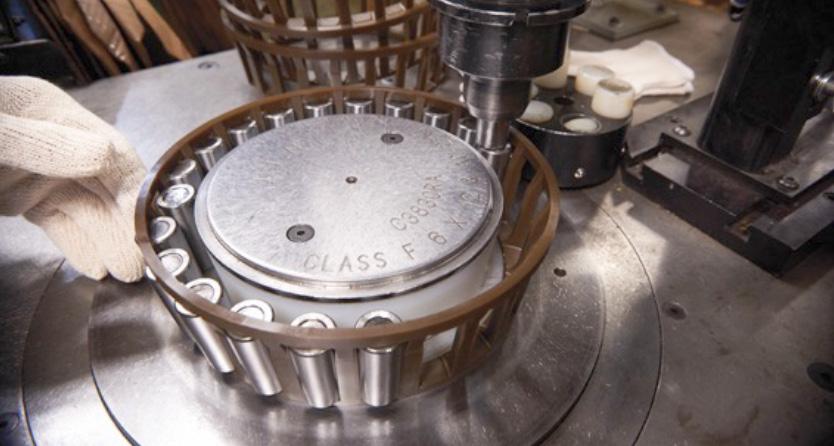

4 – Use proper lubrication practices

Incorrect lubrication is a common reason for shortened bearing life. In a properly lubricated bearing, component mating surfaces create a lubricant film that prevents metal-to-metal contact. The lubricant can also trap debris and carry it away from contact surfaces.
Repair services can save 20-80% of the cost of buying a new replacement bearing, and may take just weeks, compared with a leadtime of months or years for a new bearing. Repair is also more environmentally-friendly – getting many more service hours from the bearing before it needs to be repaired again or finally discarded.

Identify process improvements Lubrication Selection Benefits Oil Grease Carries heat away from the bearings Simplifies seal design and acts as a sealant Carries away moisture Permits prelubrication of sealed or shielded bearings Easily controlled lubrication Generally requires frequent lubrication 47 BEST PRACTICE eriks.co.uk
Spherical roller bearing
Proper handling practices for storage, removal, cleaning, inspection and installation can all optimise bearing service life.
Spherical roller bearing before bearing remanufacture .
after bearing remanufacture.
Open for (even better) business
Mick Holland Chief Product Officer

Now the novelty of shopping online has long worn off, we’ve all become ‘experienced’ customers. We all expect the same high standards of service from our web shopping as we do from any other kind. Slow service, ‘glitchy’ websites, poor functionality and lack of userfriendliness are all things we just won’t put up with any more. So behind the scenes at the ERIKS Webshop, we’ve been refurbishing, reorganising and rebuilding our capability, to give our customers a more comprehensive and satisfying digital purchasing experience they deserve, for all the essential and specialist industrial products they need. Now the doors have opened, why not come in and take a look around?

MAKING INDUSTRY WORK BETTER
Issue 47
Although the ERIKS Webshop may look similar, it’s had a root and branch rework of key aspects to make it far more robust and secure as well as open the way to creating a much more personalised rich engaging and accurate experience.
These changes also open the way to connect with our new fulfilment infrastructure. This paves the way to a much more informative and time saving functionality, a digital partner to help you get more out of your relationship with ERIKS.

Valid prices and lead times
As you peruse the many of thousands of items, you’ll see your personalised purchase price and the current lead time of an ever increasing range of products, which will be accurate no matter if the item is held in our main fulfilment centre or that of our supplier. That means when you order you can be confident that the items you requested will be with you when you expect.
You hold the cards
It’s now quick and easy to see prices in the Webshop, whether or not you have an ERIKS account. However, as an ERIKS account holder, you can log in to see personalised pricing and discounts along with any special offers.
Or, by providing a little more information, you can immediately open a business credit account..
If you don’t know precisely the item you need, or where to find it, the Webshop can help with that too.
You can either use one of the many product selection or guiding tools, or – once you’ve quickly opened an account – you can use the Request For Quote function to enter any combination of product reference, description and part number.
You’ll receive an email response with the current price for the item, and the quote will also be stored in the Webshop in ‘My Quotation’, from where you can place your order when required. The price quoted will typically be held for 30 days.
What’s in store, online?
However large or small your purchasing requirement, the improved Webshop now
makes it quicker, more efficient, and more cost-effective to source and buy your industrial products from ERIKS.
And as the full ERIKS digital purchasing experience continues to be extended, you’ll discover more ways that ERIKS can support you: from providing 360° visibility of your transactions online and at Service Centres, to offering even more comprehensive support with managing and ordering stock.
The ERIKS Webshop has been enhanced and improved, so you can enjoy the benefits now. But there’s still more to come in the future, to ensure that the ERIKS Webshop remains the top of the shops.
For businesses that want something now, you need to be able to order and pay quickly. If you are not already an ERIKS account holder, and don’t want to spend time opening an account just now, you can make instant purchases from the ERIKS Webshop using a Visa, Mastercard or Maestro credit card. And with the back-office function provided by Ingenico – one of Europe’s largest providers of technology for electronic transactions –you can be sure your payment is safe and secure.
An account to count on
What if you decide you do want a credit account with ERIKS? In the past, that meant a delay while your application was processed – and you couldn’t place any orders. With the new Webshop, that’s no longer the case. First, you find the item you want to order from the Webshop. You’ll see the market price, and if you’re happy with it you can place the item in your shopping basket. You can then either open a transactional account on the spot, and pay by credit card in a matter of minutes.
49 DIGITAL INNOVATION
Order and pay quickly
Quicker, more efficient and more cost-effective
Have you seen the light?
Tom Morgan Product Manager, Electrical

Nobody can still be in the dark about the changes that have happened – and are happening – to lighting. Starting with the banning of halogen lamps back in 2021, and now with an end to fluorescents just come into force, UK businesses are on track to save over 1.25 million tonnes of CO2 from entering the atmosphere. Not to mention significantly reducing their energy costs. But it all depends on identifying and switching off the old lighting technology, and switching on the right choice of new lamps. An ERIKS Lighting Survey will highlight your costs, and put the spotlight on the savings you could make.
Making lighting more sustainable and reducing its carbon footprint were already powerful reasons for phasing out less energy-efficient technology. The UK’s plans alone should have a carbon reduction effect equivalent to removing 500,000 cars from the road every year.
Now, with the huge increase in energy costs – and little likelihood of them returning to the levels seen before the invasion of Ukraine – there’s even more reason to swap fluorescents and any remaining halogen lamps at your site, for energy- and moneysaving sustainable LEDs.
Or perhaps you’re thinking: if the light comes on when I flick the switch, why bother? Here’s why.
Dim and dimmer
When the Government say they’re turning off certain lighting technology, it’s not going to
stop the lights coming on at your site. Not at first, anyway.

But as manufacturers wind down the production of banned fluorescents and associated parts, then replacement tubes, starters, control gear and other fittings are going to be increasingly hard to find – and more expensive to buy if you can find them.
As they get older, they’re also more likely to fail more often. Which means increased maintenance time and costs as your maintenance engineers work to keep them illuminated.
MAKING INDUSTRY WORK BETTER
Issue 47
Making lighting more sustainable
Even when your traditional lamps are actually working, it’s not all good news. Every hour they burn, they’re using more energy, producing more CO2 and costing you more money on your electricity bills than the latest LED versions.
So how much money could you actually save by making the change to new LED lamps sooner rather than later?
Don’t work in the dark Lighting is not simply a matter of ‘On’ or ‘Off’. So an ERIKS lighting survey is not just a case of checking your lights work. It’s about checking your lamps are the right type, doing the right job, and doing it as cost-effectively and energy-efficiently as they can.
What kind of lamps do you have on your site? How much are they costing you to run? How much could you save by switching them to LEDs? How long would the payback period be? And are there new technologies – such as presence detectors or circadian lighting – which you could be using to increase the energy-efficiency of your lighting, or to help to enhance the productivity, health or comfort of your employees?
These are all facts you need to know before you can make informed decisions which could significantly reduce your bills, shrink your carbon footprint, and even enhance employee productivity.
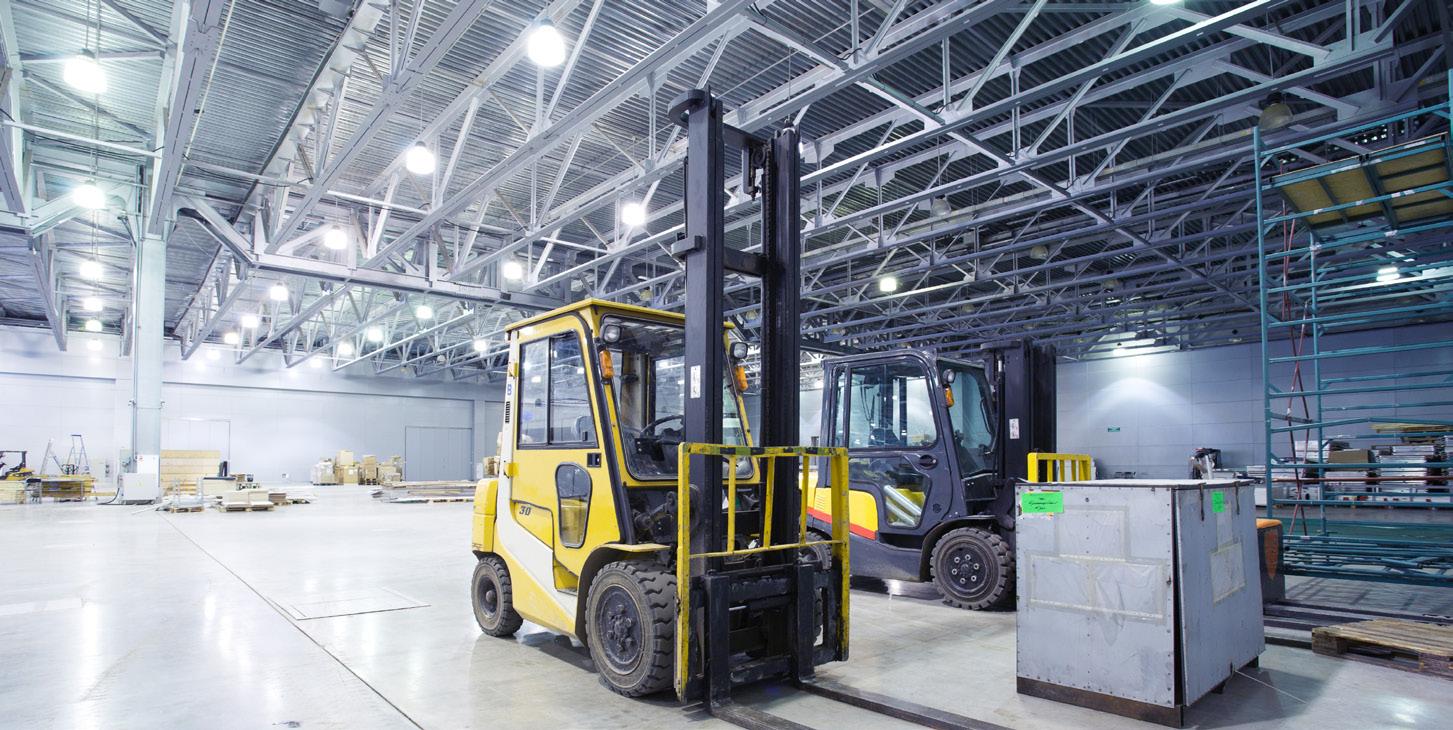
The first step – and a much easier one than visiting every location on your site and inspecting what’s fitted on the ceiling – is to carry out your own quick survey of the lamps currently on the shelves in your storeroom.
Are there fluorescent tubes, and mercury or sodium lamps? In that case, your lighting could be in need of an urgent energy-saving overhaul, before your existing lamps start to fail, your stocks of spares begin to run down, and you start to struggle to find replacements at a reasonable cost. A more comprehensive survey could potentially identify real energyand cost-saving solutions.
Contact your local ERIKS representative to discover how ERIKS and Thorn Lighting could help you see the light.
the spotlight
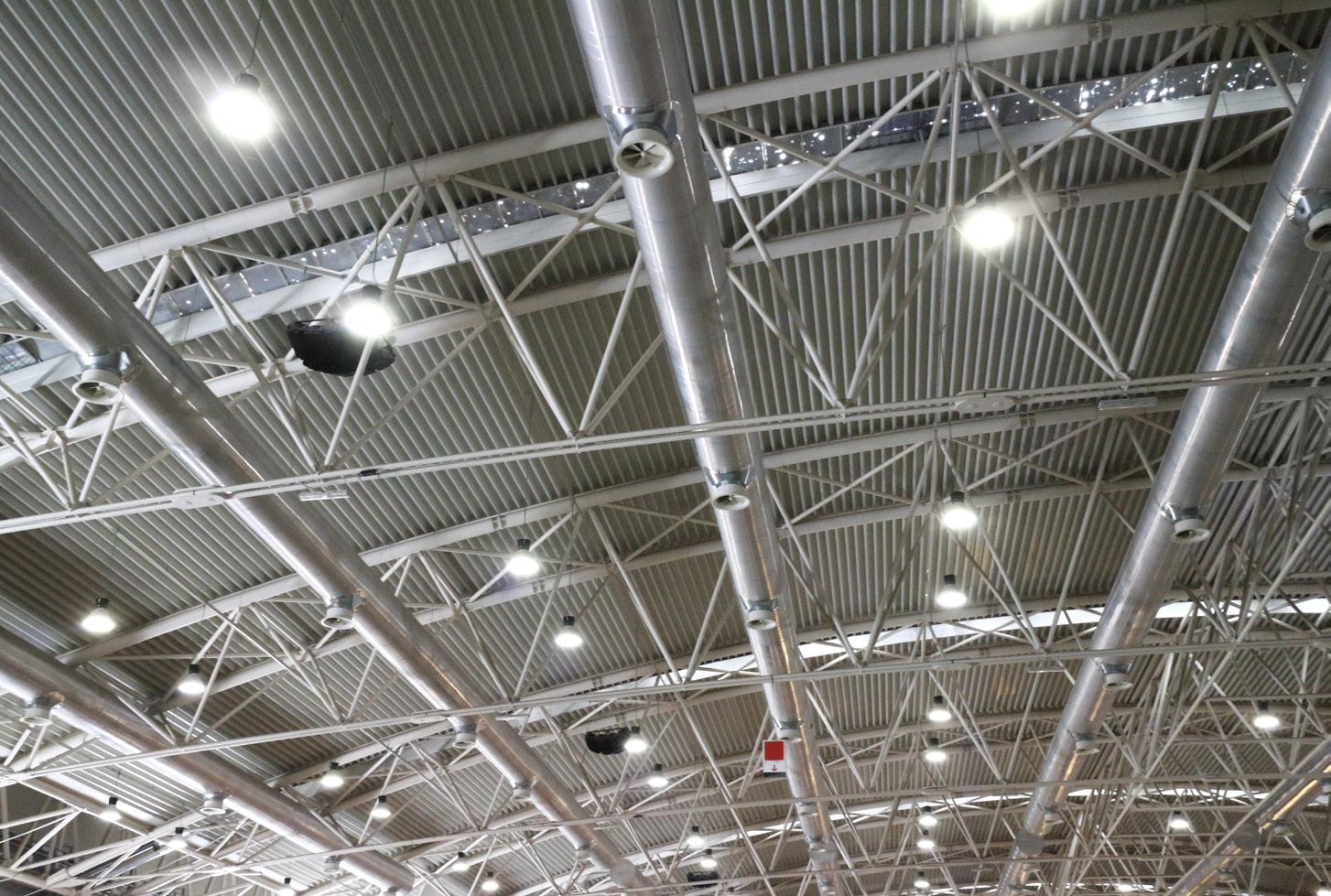
Old-Style Lighting Technology New Lighting Solutions
eriks.co.uk 51 HEALTH & SAFETY
In
A recent ERIKS and Thorn Lighting survey revealed the potential savings on one production site for a global pharmaceuticals manufacturer, by switching to new LED lighting. Illumination
Hrs per day 24 24 Days per week 7 7 Wks per year 51 51 Total hours 8568 8568 kWh £0.25 £0.25 Total W per annum 402,867.36 197,948.22 Cost per annum £100,716.84 £49,487.05 Kg of CO2 produce per year 145,032 71,261 SAVINGS PER ANNUM £51,229.79 LIFE YEARS (50,000 HOURS) 5.84 OVERALL SAVING £298,960
Cost-effectively and energyefficiently
Significantly shrink your bills
Does your PPE stand for ‘Pen and Paper Exercise’?
For EH&S Managers, PPE checks are an essential part of the job. But they’re also hugely timeconsuming, and generate large amounts of paperwork. 3M Connected Safety could be the answer to saving time – without cutting corners on safety and compliance.

MAKING INDUSTRY WORK BETTER
Issue 47
What does your usual PPE inspection regime look like? About 30% inspection and 70% paperwork?
Noting what’s present, what needs replenishing, and what’s due for maintenance. Writing-up the calibration checks and results on the spot. Recording with pen and paper what’s been checked and when. Taking all the notes back to your desk to enter into a spreadsheet on your PC. Plus printing-out all the latest documentation, and updating binders with hard copies for all the stakeholders involved.
Then if someone needs access to the information when they’re out on site, the only way they can get it is by having a hard copy with them, or by contacting you. And when an audit is due, you’ll need to spend yet more time gathering the information together in a suitable format ready for inspection. There has to be a PPEasier way.
Data is instantly uploaded to the cloud for secure storage, but is also quickly accessible to anyone with the necessary authorisation. No more manually updating a spreadsheet back in the office. No more endless printing. No more hard copies and ring binders. Everything anyone needs to know is instantly available, literally at their fingertips.
Be safe, be sure, be ready
Your regular PPE checks are as vital as the PPE itself. But pen and paper recording of the checks on the spot can lead to errors. And keyboard entry onto a spreadsheet is a chance for something to be mistyped or missed out.
So even if the PPE is correct, the documentation may not be. Or, potentially more dangerous, the PPE may be unsafe –in need of maintenance, for example – or may have been missed on a check, but the documentation says its okay.
The system ensures all equipment is checked on schedule with nothing overlooked, and that all necessary documentation to prove it is in perfect order, available from the cloud in seconds.
Paper cuts and safety
A leading cable manufacturer opted to cut out their pen-and-paper system in favour of the 3M Connected Safety system and digital app.

70% time saving
By removing the need for manual recording on site, manual data entry back in the office, and printing of multiple hard copies, the result was a staggering 70% time saving for their EH&S team, and a huge saving of paper. But all without compromising safety.
Write-off the pen and paper

3M Connected Safety lets you swap pen and paper for phone and software.
With the Connected Safety app loaded onto your mobile, instead of making a handwritten note of PPE location, condition, maintenance status and so on, all you have to do is scan any of the following: RFID chip, data on the item or simply enter the items ID number. This will identify the equipment, provide all the necessary details, and allow for quick and easy updating on the spot.
With the 3M Connected Safety app, that can’t happen. The software includes a Task List which colour codes actions green if an item is due for checking in the near future, and red if the check is overdue. It also provides an alert if something is missed.
Whether that sounds impressive or hard to believe, there is a Return On Investment calculator tool which you can use to identify how much time you can save in your own organisation by using the 3M Connected Safety system.
ERIKS is one of the first 3M partners to have the 3M Connected Safety system available now. So it’s time to make PPE stand for ‘Please Phone ERIKS.’
And because the system helps keep everything up-to-date, and keeps all records securely in the cloud, when the time comes for an audit there’s no last-minute panic to get equipment and documentation ready.
53 INNOVATION
There has to be a PPEasier way Everything up-to-date
eriks.co.uk
Fast Track to
Sustainability and reliability are as important in motorsport as they are in manufacturing industry. In all walks of engineering there is the pressing need for top performing maintenance products that enhance productivity and save costs but not at the expense of worker safety or environmental responsibility. In its choice of LOCTITE, Porsche has struck the perfect balance and it’s a partnership that is intent on delivering, in each race, the best possible performance in the ABB FIA Formula E World Championship.
This championship competition carries high levels of prestige as the globe’s most disruptive all-electric motorsport series. With a strong legacy of performance, innovation, reliability and sustainability, LOCTITE is the Official Adhesives Partner for the TAG Heuer Porsche Formula E Team, offering premium professional products and extensive technical expertise on the Porsche 99X Electric, the company’s first all-electric racing car.
As most can imagine, there is no margin for failure when providing adhesives for a project of this nature. The Porsche brand will not tolerate damage to its reputation, while a top speed of 280 km/h means safety and reliability are paramount across 16 ‘E-Prix’ races around the world. Furthermore, sustainable development is a key element of the ‘Porsche Strategy 2030’, in line with which, the company looks to avoid and reduce carbon emissions across its entire value chain.
The ABB FIA Formula E World Championship, the most sustainable motorsport series in the world, actively promotes electric mobility and innovative mobility solutions that contribute to reducing air pollution and fighting climate change. Both Henkel and Porsche have set themselves the goal to drive progress towards a sustainable future. The adoption of each LOCTITE product is carefully selected for use on the 99X Electric in line with these goals.
As part of the partnership, the TAG Heuer Porsche Formula E Team deploys LOCTITE products that include a number of highperformance epoxy adhesives, retaining compounds, gap-filling adhesives, threadlockers (medium and high strength), structural adhesives, thread sealants, instant adhesives, accelerators and parts cleaners. Using these products ensures complete mechanical reliability for a host

of key applications, which extend from suspension bearings, gearbox housing parts and powertrain bolts, through to steering wheel components, O-rings and cables.
By using the structural adhesive products in particular, Porsche avoids the need for traditional mechanical joining methods like fastening or welding, reducing electricity consumption and carbon emissions through the elimination of hole-drilling and edgepreparation processes. Test rigs for engines and gearboxes also benefit from highperformance LOCTITE solutions.
Among the application examples is the powertrain. The importance of the powertrain to race success is paramount, so LOCTITE 243 medium-strength threadlocker has a key part to play. All of the connecting stud bolts between the vehicle chassis, engine, transmission and final drive are subject to great stress, since the drivetrain
MAKING INDUSTRY WORK BETTER
Issue 47
Success
is a load-bearing part of any race car. Securing the bolts with LOCTITE 243 prevents loosening and failures, which not only lead to uncontrollable race-car behaviour, but place the driver in life-threatening situations. At the same time, the TAG Heuer Porsche Formula E Team engineers can disassemble
the bolts using hand tools whenever required for upgrades, maintenance or repair. The majority of the LOCTITE products in use at the TAG Heuer Porsche Formula E Team suit both OEM build and maintenance/repair applications.

Ultimately, the partnership illustrates many shared brand values, not least innovation, reliability, environmental responsibility and product sustainability. The partnership also strengthens the knowledge base of both companies. In order to be successful in such a highly competitive racing series as the ABB FIA Formula E World Championship, the TAG Heuer Porsche Formula E Team needs strong

partners that share its commitment and vision for the future of motorsport. Despite all of the good intentions, only results on the track will determine success, although the partnership is already delivering on that ambition. The TAG Heuer Porsche Formula E Team notched up its first win in the ABB FIA Formula E World Championship at the Mexico City E-Prix in February 2022. The team’s drivers, Pascal Wehrlein and André Lotterer finished first and second respectively, making it a true banner day for Porsche.

55 RELIABILITY
eriks.co.uk
UK Growth: think beyond the sound-bite!
As humans, we’re programmed to look for instant gratification. Behavioural scientists call this the Hyperbolic Discounting Bias: the inclination to choose rewards today rather than in the future, even if future rewards are larger and guaranteed.

Look at this another way, and you’ll see that our desire for instant gratification is constantly being fed by our always-on world, by 24/7 availability of social media, news and entertainment. We’re becoming experts at short-termism – and the proliferation of digital devices, apps and channels is making things worse. Cast your mind back a few years and you may remember stories about the average human having an attention span that was shorter than a goldfish; i.e. less than nine seconds!
The problem is that for our society, businesses and economy – for the overall good of the nation – the last thing we need right now is short-termism. Unfortunately, many – not all – of our politicians in their thinking, communications and policy making seem more interested in today’s sound-bite than they are in a long-term strategic vision and plan that will take us forward and grow our economy over the next decade.
The recent debacle over the Tory leadership election and subsequent fall-out was a classic example of short-termism. Countless promises of ‘jam today’ without a realistic plan to explain how this would be achieved led to the abrupt end of Trussism and her brand of neo-liberalism. Since then, although the current Government appears to offer greater stability, it continues to represent a party that is bereft of fresh ideas beyond a repetition of the politics of austerity.
These have been tried for the last decade and have singularly failed. For example: the UK growth rate and outlook are among the worst in the G7 economies; we have record levels of child poverty; our education and health systems are in crisis; and our transport infrastructure outside London and the South East is under extreme stress.
On a more positive note, we should not forget that despite the travails of Brexit, the pandemic and recent global crises, we continue to have vibrant manufacturing, science and financial sectors. The fact that these sectors are doing well, however, is primarily down to the ambition, skills and expertise of individual organisations, not Government policies.
We could be doing so much better if we had a political system that encouraged both long-term thinking and the promotion of independently minded visionaries and thinkers capable of rising above short-term parliamentary interest.
Nowhere is this absence more evident than in the area of investment, which is the lifeblood of a growing, dynamic and successful economy. Investment – not further cuts – is now required at a national level, in education, skills and training, in healthcare and in utilities and infrastructure. In turn, this requires a long-term, holistic vision that recognises that prosperity depends on a healthy, welleducated, skilled and motivated society,
where everybody has equal opportunities.
This environment then gives business the confidence to invest, further driving prosperity and opportunity.
Manufacturers for example want certainty, stability and the prospect of sustained economic growth on which to base their future investment plans. They also want a coherent industrial strategy that is part of a wider vision for the country as a whole and its place on the world stage.
The manufacturers’ organisation, Make UK, is rightly calling for the government to commit to the success of UK manufacturing, beginning with the creation of a new cabinet-level appointment of a Minister for Manufacturing.
This would be an excellent first step, but such a person must have a good understanding of the sector and not just be a political appointee. More to the point, they need to have the ability to plan and deliver a long-term industrial strategy. This will need to be developed in consultation with industry bodies, as well as SMEs and large industrial organisations; and it will have to encompass many different aspects of the wider economy, such as training, skills and workforce mobility, that are essential to national growth and prosperity. It’ll be a tough challenge but it’s one that we cannot afford to ignore.
Issue 47
DEBATE
You see steam. We see...



























Steam – this extraordinary, energy dense, fluid which is irreplaceable in all kinds of industries to heat, power and sterilize – leaving nothing but water behind. And with advancing steam generation solutions, steam is part of our sustainable future.







This is Natural Technology.
Discover Natural Technology at natural-technology.com
No substitute for know-how
When there are only three factories worldwide manufacturing a product, downtime is a huge issue. So when Sensus – producers of the sugar and fat substitute inulin – needed a quick and reliable solution to repeated problems in their demineralisation plant, they challenged three suppliers to come up with the answer.


The sixteen silos in the most critical part of the entire production process were suffering repeatedly from failing butterfly valves. Whenever a valve leaked or broke down entirely, production capacity had to be reduced while engineers worked to get the process up and running again as quickly as possible.
But it was not just lost production which was affecting business. It was also the lack of operational reliability.
To save time on finding a workable solution, Sensus approached three of their regular suppliers with the same demand: find a valve to provide the operation reliability required, to minimise unexpected maintenance and associated costs – and back it up with a 10year guarantee.
so that – in the words of Martin Geuke – ‘the plant could just keep running.’
To discover how ERIKS can support your food production business, be sure to read the next issue of Know+How, focused on food and clean environments. And meanwhile, why not download ERIKS’ 50+ Top Tips for better food safety.
Tried, tested and trusted
First, ERIKS’ specialists assessed the process and investigated which valves might best meet the requirements. Then ERIKS and Sensus together carried out two months’ worth of extensive tests to ensure the chosen butterfly valves would work correctly and without leaks.
Once their effectiveness was proven, the new ERIKS butterfly valves were installed in the first of the plant’s four lines, with the remainder to follow over the next few years. The result over the ten year guaranteed life of the valves will be savings of approximately €800,000 on unforeseen repair costs and unplanned downtime.
ERIKS rose to the challenge.
Understanding the question It was ERIKS’ approach to understanding the question which not only helped them find the most effective answer but also won them the business.
‘ERIKS simply understood our question best,’ said Sensus Purchasing Manager Martin Geuke. ‘They worked proactively with us to find a good solution.’
For ERIKS, it wasn’t only about the immediate issue, but also about optimising the process
Martin Geuke is a firm believer in businesses which work together having trust in each other. ‘We certainly had that trust and now with this result… our factory will be even more stable thanks to ERIKS.’
Issue 47
ERIKS rose to the challenge
approximately €800,000 KNOW+HOW
Optimising
the process
Savings of
PPE Safety Solutions

Products that work as hard as you do. From the most basic to the most specialised needs, 3M offers the health and safety protection you and your workers need most, so everyone can perform at their best. www.3M.co.uk/safety www.3mireland.ie


Online Vibration Monitoring 3 simple steps to improve productivity Call 01 21 508 6000 or visit eriks.co.uk Let’s make industry work better 3 2 1 ERIKS install and commission vibration monitoring systems on agreed assets You receive daily asset condition reports, impending problems are highlighted Receive suggested recommendations for problematic assets, to plan and schedule maintenance































 Mahesh Patel Engineering Manager, Rotating Equipment
Mahesh Patel Engineering Manager, Rotating Equipment










































 Dave Wilson Power Quality Solutions Manager
Dave Wilson Power Quality Solutions Manager





















 Dennis Briggs-Price UK Aftermarket Field Sales Manager
Dennis Briggs-Price UK Aftermarket Field Sales Manager






 Jemma Potter Key Accounts Specialist, EMEA Industrial Sales, Mature Market Regional Sales UK
Jemma Potter Key Accounts Specialist, EMEA Industrial Sales, Mature Market Regional Sales UK




 Greg Wainhouse Industry Account Manager, Water
Greg Wainhouse Industry Account Manager, Water






































































